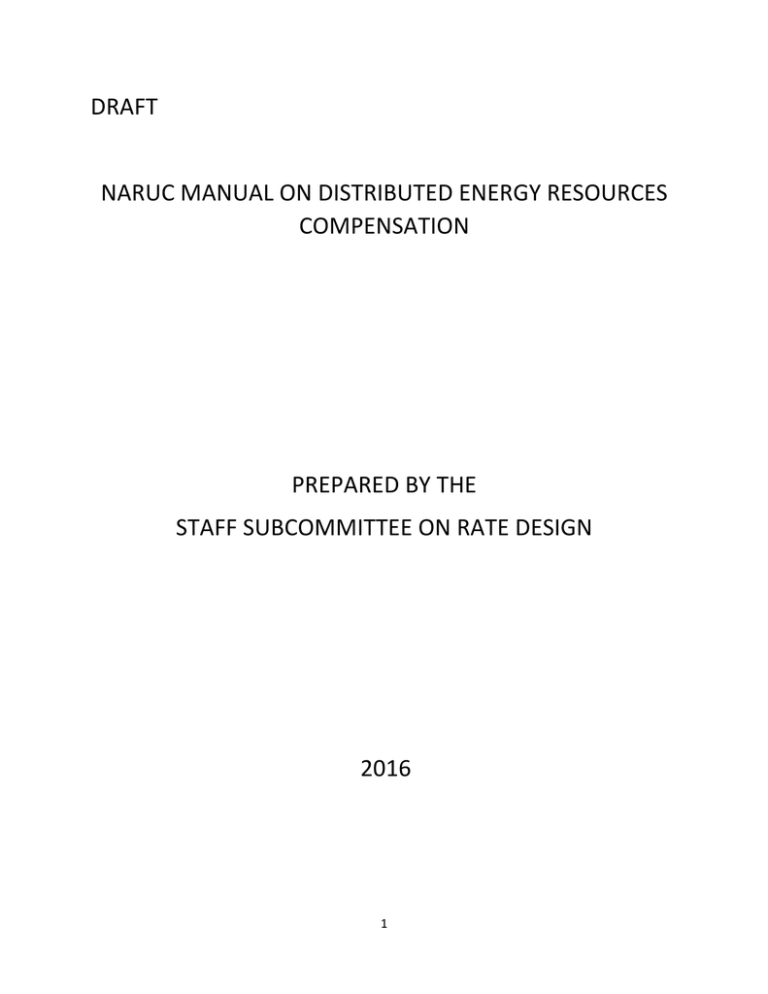draft naruc manual on distributed energy resources compensation
advertisement

DRAFT NARUCMANUALONDISTRIBUTEDENERGYRESOURCES COMPENSATION PREPAREDBYTHE STAFFSUBCOMMITTEEONRATEDESIGN 2016 1 2 TABLEOFCONTENTS TableofContents 3 Introduction 4 WhatistheRateDesignProcess 6 WhatisDER? 15 Ratedesignandcompensationconsiderations,questions,andchallenges 28 CompensationMethodologies Technology,Services,andtheEvolvingMarketplace 3 41 60 I. Introduction OnNovember11,2015,atitsAnnualConvention,theNationalAssociationofRegulatoryUtility Commissioners(NARUC)adoptedaresolutiontocreateaStaffSubcommitteeonRateDesign.1The purposeofcreatingthisStaffSubcommitteewastoprovideaforumforstatecommissionstaffto discussratedesignchallengesintheirstateswithstafffromotherstatecommissions.TheStaff Subcommittee’spurviewincludeselectric,water,andnaturalgasratedesigntopics.TheStaff SubcommitteealsoworkswithotherNARUCStaffSubcommitteeswhereareasofinterestoverlap.For example,theStaffSubcommitteeonRateDesignworkswiththeStaffSubcommitteeonWaterwhen appropriate,andalsoworkswiththeEnergyResourcesandEnvironmentStaffCommitteeonother selectratedesignissues. InitsResolutioncreatingtheStaffSubcommitteeonRateDesign,NARUCrecognizedtheincreasing importancethatratedesignissueshasonpolicydevelopmentacrossthestates,mostnotablyasit appliestodistributedenergyresources(DER).UponhiselevationasPresidentofNARUC,Montana PublicServiceCommissionCommissionerTravisKavullaannouncedthattheStaffSubcommitteeonRate DesignwouldprepareaDERcompensationmanualtoassistjurisdictionsinnavigatingthechallenges, considerations,andpolicydevelopmentrelatedtocompensatingDER.AsstatedbyNARUCPresident Kavulla,“thissubcommitteewillworktocreateapracticalsetoftools—amanual,ifyouwill—for regulatorswhoarehavingtograpplewiththecomplicatedissuesofratedesignfordistributed generationandforotherpurposes.”2ThedevelopmentofthisManualisinresponsetoNARUC’s resolutionandtherequestoftheassociation’sleadership. ThegrowthofDERacrossthejurisdictionsposesuniquechallengestoregulators.Thetraditionalways ofelectricitydeliveryfromlargepowerplantsovertransmissionanddistributionwirestothecustomer areincreasinglybeingchallengedduetothegrowthofDER.DERareresourceslocatedonthe distributiongrid,oftenlocatedonthecustomer’spremise,andarecapableofprovidingmanyservices tothecustomerandthegrid.ADER,likerooftopsolargeneration,canoffsetthepremise’s consumptionanddeliverexcessgenerationontothedistributiongrid.DER,likedemandresponse,can allowdemandtorespondtosystempricesandconditions.DERisnotsimplysupplyordemand,as traditionallythought,butcanbemultipletypesofresources,suchasstorageoradvancedtechnology pairedwitharesource,capableofprovidingavarietyofbenefitsandservicestothecustomerandthe grid. Furthermore,traditionalutilityandregulatorymodelsbuiltontheassumptionoftheutilityproviding enoughelectricitytomeettheentireneedsofitsserviceterritoryareunderpressurebyDER.New investmentswillbeneededtobetterhandlethistwo-wayflowofelectricity,newwaysofallowingthe utilitytorecoveritscostsmaybeneeded,andnewassumptionsaroundcustomerdemandwillbe necessarytomeetthischallenge.AjurisdictionwillneedtoidentifyitscurrentstatusregardingDER, 1 “ResolutiontoCreateaNARUCStaffSubcommitteeonRateDesign,”NARUC(November11,2015) (http://pubs.naruc.org/pub/D2DDD7AC-E73C-B386-630C-B88491DD0608). 2 InstallationRemarksofNARUCPresidentTravisKavulla(November10,2015)(https://www.naruc.org/aboutnaruc/press-releases/pr-111015/). 4 whatroleitexpectsDERtohaveinthefuture,understandthenatureofDERadoptionrates,and identifynecessarypolicydevelopmentstoaccommodatethatfuture. ThisManualisintendedtoassistjurisdictionsindevelopingpoliciesrelatedtoDERcompensation.Itis alsointendedtobesimilartootherNARUCmanualsontopicssuchascostallocationandnaturalgas ratedesign.ItspurposeistoassistjurisdictionsinidentifyingissuesrelatedtoDERandassistregulators inansweringquestionsinawaymostappropriateforitsjurisdiction.ThisManualprovidesregulators withpossibleoptionsthatajurisdictionmaywanttoconsiderandadopt.ThisManualshouldbe applicableregardlessofmarketstructure(restructuredversusvertically-integrated),organized wholesalemarketornot,oradoptionoftechnology,beitadvancedutilityinfrastructureoravailability ofcustomer-sitedtechnology. ThisManualisorganizedinfivemainsections.Section2describesthebasicratedesignprocessand howDERimpactsthatprocess.Section3discusseswhatisDERandwhyitisimportantforstatesto consider.Section4isaboutthesystemicchallengesandquestionsraisedbythedetailsofratedesign andcompensation.Section5outlinesavarietyofpossibleDERcompensationmethodologiesthata jurisdictionmayconsider.Lastly,Section6providesadescriptionofadvancedtechnologiesthatcan potentiallyassistaregulatorandutilityinplanningandmonitoringDERdevelopment,and considerationsforwhenitmaybeappropriatetoreconsiderexistingDERcompensationmethodsbased onDERadoptionlevelsinajurisdictionorutilityserviceterritory. ThisManualprovidesasnapshotatoptionsavailabletoday,andtheroleofadvancedtechnologyinthe futuretoassistaregulatorinmonitoringthedevelopmentofDER.ThisManualcannotpredictthe future,suchasfutureusesofDER,futureDERtechnologies,futurebusinessmodeloptions,orany unanticipatedadvancementsinmarketdevelopmentorpolicydevelopmentthatmayimpactthistopic. Giventhatlimitation,thisManualwillhopefullyprovideregulatorswiththeabilitytomeetcurrent needsandplanforfuturedemands.Howitisultimatelyusedwillbedecidedbyregulators,utilities, customers,andotherparticipants.Asthepaceofchangedevelopsovertime,itshouldbeexpectedthat thisManualwillberevised,ascircumstanceswarrant. TheStaffSubcommitteeonRateDesignthanksallwhohaveassistedinthedevelopmentofthisManual, andappreciatesthetimeandeffortofthoseontheStaffSubcommitteewhoassistedinthe developmentandreviewofthisManual,andthosewhohaveprovidedinputand/orcommentsonthis Manual. 5 II. What is the Rate Design Process A. Definition,Principles,Goals,andPurpose BeforegoingintothedetailsofratedesignimpactsfromDER,afoundationmustbesetrelatingtothe basicpurposesforratedesignandassociatedfoundationalprinciples.Additionally,akeycomponentof understandinghowratesaredeterminedincludestheimportanceofunderstandingcostsandwhat costsautilityisallowedtorecoverbytheregulator.Thissectionprovidesanoverviewofthesetwo stepsinmostbasicratedesignprocessesacrossthecountry.Aspartofthisdiscussion,itisrecognized thatmostexistingratedesignsarenotexplicitlydesignedtoreflectaccuratecoststoserveeach customer.Electricitycostsvarythroughouttheyear,month,week,day,andhour;ratedesignbalances thisrealitytoallowfortheutilitytorecoveritstotalcostsofservice(i.e.,revenuerequirement),over thecourseoftime,beitmonthly,yearly,oracrossratecaseproceedings.Thisaveragingofcostsintoa ratesuppliesaconvenientrateovertime,butdoesnotreflectthechangingnatureofelectricitydelivery (particularlywithincreasingamountsofDERmaterializing).DERmayimposenewcostsontotheutility, costswhichneedtoberecoveredtoensuretheutility’sfinancialhealthandtoallowtheutilityto recovernecessaryinvestmentsinthedistributiongridtomaintainreliabilityandqualityofservice. Identifyingtheappropriateprinciples,goals,andobjectivesforratedesigncanassistaregulatorin determininganefficientrate(orcompensationmethodology)thatcollectstheauthorizedutilitycostsor authorizedrevenuerequirement. 1. Rates Ratedesign,theprocessoftranslatingtherevenuerequirementsofautilityintothepricespaidby customers,isoftensaidtobemoreartthanscience.Whilethereisoftenagreementamongstthe partiestotheratesettingprocessonthevariousgoalsandprinciplesofratedesign,theweightsgiven bythedifferentpartiestoeach,andtheopinionsonthespecificsoftheirapplication,varygreatly.Rate designmaybeinfluencedbylegislativeinitiativesandpoliticalandenvironmentalpolicies.However,a singleratedesigncannotmeetallratedesignprinciplesandallpolicygoals.Indeed,manyofthegoals andprinciplesconflictwithoneanother,anditisthejoboftheregulatortostrikeabalancebetween theseprinciplesandgoalsthatbestreflectsthepublicinterestastheyseeit. Thebasicpurposeofratedesignistoimplementasetofratesforeachrateclass–residential, commercial,andindustrial–thatproducesrevenuestorecoverthecostofservingthatrateclass.In practice,ratesarenotbasedonanindividualcustomer’scosttoserve,rathersimilarcustomersare accumulatedintorateclasses,andthetotalcosttoserveallofthecustomersinthatrateclassis allocatedequallyacrossallofthecustomersinthatrateclass. Overtheyears,severalauthorshavelaidoutgoalsandprinciplesofratedesignthatcontinuetobe referredto,bothbymorerecentauthors,aswellasthevariouspartiestotheratesettingprocess.One oftheseenduringauthorsisJamesBonbright,whosePrinciplesofPublicUtilityRatesliststhefollowing criteriaofadesirableratestructure: 1. Therelated,practicalattributesofsimplicity,understandability,publicacceptability,and feasibilityofapplication. 2. Freedomfromcontroversiesaboutproperinterpretation. 6 3. Effectivenessinyieldingtotalrevenuerequirementsunderthefair-returnstandard. 4. Revenuestabilityfromyeartoyear. 5. Stabilityoftheratesthemselves,withaminimumofunexpectedchangesseriouslyadverse toexistingcustomers 6. Fairnessofthespecificratesintheapportionmentoftotalcostsofserviceamongthe differentconsumers. 7. Avoidanceof“unduediscrimination”inraterelationships. 8. Efficiencyoftherateclassesandrateblocksindiscouragingwastefuluseofservicewhile promotingalljustifiedtypesandamountsofuse a. inthecontrolofthetotalamountsofservicesuppliedbytheCompany b. inthecontroloftherelativeusesofalternativetypesofservice(on-peakversusoffpeakelectricity,Pullmantravelversuscoachtravel,single-partytelephoneservice versusservicefromamulti-partyline,etc.).3 Bonbrightdistillsthesedowntothreeprimaryobjectivesofratedesignfromwhichhisothersflow: (a) therevenue-requirementorfinancial-needobjective,whichtakestheformofafair-return standardwithrespecttoprivateutilitycompanies; (b) thefair-cost-apportionmentobjective,whichinvokestheprinciplethattheburdenof meetingtotalrevenuerequirementsmustbedistributedfairlyamongthebeneficiariesof theservice;and (c) theoptimum-useorconsumer-rationingobjective,underwhichtheratesaredesignedto discouragethewastefuluseofpublicutilityserviceswhilepromotingallusethatis economicallyjustifiedinviewoftherelationshipsbetweencostsincurredandbenefits received.4 2. Costs Whilethemostcommonlyusedformsofratedesignmaynotbeanattempttocommunicatecostswith perfectaccuracytothecustomer,thecostofservingthatcustomerisanindispensablyimportant ingredientinanyratesystem.Tocreateanappropriaterate,itisimportanttodistinguishbetweenfixed andvariablecosts.Suchadistinctioninforms,thoughdoesnotentirelydecide,thebasisonwhichthose costsshouldbecollected.Separately,aregulatormayalsochoosetohavetheratesendapricesignal tothecustomerwhichmayreflectamoreaccuratepricerelatedtothecosttoserveacustomerata certainpointintimeoroveraspecifiedtimeperiod.Intheshort-term,manyofthecostsofautilityare fixed.Inthelong-term,manyofthecostsofautilityarevariable.Thequestion,then,ishowmuchofa utility’scostsshouldbeconsideredfixedforthepurposesofsettingrates.Here,also,thereismuch disagreement.Intheshort-tomid-term,costsarenotterriblysensitivetochangesinuse.Asaresult,a customerwholowerstheirusecreatesanadditionalburdenonothers,asthecostsmustbecoveredby someone.Othersarguethattheappropriatetimehorizontopricethesecostsover,becauseof economictheoryorthelongplanninghorizonoftheutility,isthelong-term. 3 JamesC.Bonbright,PrinciplesofPublicUtilityRatesat291(1961). 4 Id.at292. 7 Themajorityofratedesignconsiderationshavecorrespondingconsiderationsforcostallocation,and vice-versa.Totheextentthatregulatorsdesireratestobebasedoncost-causativeelements,the allocationofthosecostsis(orshouldbe)onthebasisofthosecost-causativeelements.Theregulator maydecidethattheallocationofcostsshouldreflectdecisionsmadeaboutthewaythosecostsare collected,orvice-versa.5Thisalsomitigatespotentialintra-andinter-classsubsidies. B. IntroductiontoRateDesign 1. BasicServiceRates Thereareseveralwaystostructuretheratespaidbycustomers.Eachtendstoaccomplishcertain principles,goals,andobjectivesofratedesign,asdeterminedbytheregulator,whileneglectingothers. Ratescanalsobecombinedinvaryingdegreesinanattempttobalancetheobjectivesofthe jurisdiction. a. Flatrates Aflatratedesignchargescustomersaperunitchargeregardlessofconsumption.Thetotalcosts(or somesubset)allocatedtoaclassaredividedbytheusageofthatclasstoproducearate.Thisrateis thenuniformlyappliedtoanyusagebyacustomerwithinthatclass.Thisratestructure(incombination withamonthlycustomercharge)iscommonlyusedindesigningratesforresidentialelectriccustomers. Indeed,thisisthemostcommonformofresidentialratedesignacrossthecountrytoday.Dependingon theobjectivesidentifiedbythestate,aflatratecanmeetsomeofthem,suchasaffordability.Onthe otherhand,recognizingthatthecostofelectricityvariesthroughoutthedayandbylocation,aflatrate maynotreflectthecoststoserveacustomeratagiventimeperiod.Forexample,ittendstocostmore toservecustomersduringpeakperiodsduetotheincreasingmarginalcostofgeneration(i.e.,peaking generationplantshavehigheroperationalcosts,whichisreflectedinwholesaleelectricitycosts),and shortageofavailablecapacityonthetransmissionand/ordistributiongrid.Aflatratedoesnotreflect theseconditions.Aflatperunitratetendstobenefitlow-usecustomersandposessomedisadvantages tosomecustomerclasses,suchasC&Icustomerswithhighloadfactorsandhighvolumetric consumption.Forexample,iftheprovisionofservice(i.e.,generationasreflectedin$/kWh)ismore expensiveatcertaintimesofday,thisratefailstoreflectthat,andthosecustomersusingproportionally moreoftheirelectricityatthehighercosttimesarebeingsubsidizedbythosewhouseproportionally moreatlowercosttimes.Additionally,supplycostscanvarydailyandhourly,andtherefore,aflatper unitratesendsapoorpricesignalforsupplyresourcesiftheydonotreceiveatime-differentiated wholesalepricethatreflectsthevalueoftheirproduction. b. BlockRates Anincreasingorincliningblockrate(“IBR”)structureisdesignedtochargecustomersahigherperunit rateasthecustomer’susageincreasesovercertainblocksofusagewithinabillingcycle.Forexample,a threetierIBRwouldidentifythree“blocks”ofusage.Blockonewouldbe0-150kWh,Block2wouldbe 150kwh-250kWh,andBlock3wouldbeallusageover250kWh.Foreachblock,therewouldbeaprice forallelectricitychargedinthatblock,withthepriceincreasingasacustomermovesthroughthe 5 Foranintroductiontocostallocationmethodologies,see,“ElectricUtilityCostAllocationManual,”NARUC (January1992). 8 blocks.OneofthemainpurposesofanIBRistosendaconservationsignaltocustomersandto incentivizeenergyefficiencyandreduceconsumptiononthesystem.Inotherwords,astheprice increaseswitheachblock,customersmaybeencouragedtoconservetoavoidthehigherblockprice overabillingcycle.IndesigninganIBR,someconsiderationsmustbemade,suchastheprice differentialsbetweenthevariousconsumptionblocksandtheavailabilityoftimelyconsumption informationtocustomers.Ifcustomersdonotpossesstheabilitytoaccesstheirconsumptiondata throughoutthebillingcycle,theywillnotknowwhenadditionalconsumptionreachesthehigherblock rate.AnotherconsiderationisthatIBRsimposehigherperunitcostsonhigh-usecustomerseven thoughdeliveringadditionalvolumesmaynotincreasethecostsofprovidingdeliveryservice.Although theincentivetoconserveovertimeisgreaterwithanIBRdesignthroughavoidinghigherpricesoverthe month,thisratedoesnotreflectthehourlyordailychangestothecostofelectricity.Acustomermay paymoreforelectricityoveragivenmonth,eventhoughamajorityofitsusagemaybeentirelyoffpeak;sinceanIBRdoesnotreflecttheday-to-dayconsiderationsofpeakandoff-peak,acustomermay overpayforelectricityascomparedtoitsotherwisebasiccostofservice. Adecreasingordecliningblockrate(“DBR”)structureisdesignedtochargecustomersalowerperunit rateasthecustomer’susageincreaseswithinabillingcycle.DBRsarestillsometimesusedtoreflect decreasingfixedcostsasoutputincreases;ahigherinitialratewouldrecoverinitialfixedcosts,andrates woulddecreaseovertheblocksastheratereflectsmorevariablecosts.However,byloweringthe savingspotential,DBRsdiscourageconservation,energyefficiency,andcustomeradoptionof technologiesthatmayreduceconsumptionorotherwisereflectcosts. c. TimeVariantRates Timevariantratesaredesignedtorecognizedifferencesinautility’scostofserviceandmarginalcosts atvaryingtimesduringtheday.Generally,atimevariantratedesignchargescustomersahigherprice duringpeakhoursthanoff-peakhours.Unlikeflatrates,customersneedtobeawareofusage throughoutthedayandthemonthtorespondtothepricesignalsinatimevariantratedesign.A customermayincreasesavingsunderatimevariantratecomparedtoaflatrate,ifthatcustomeruses energyappropriatelyduringspecificpeakandoff-peakhours.Avarietyoftimevariantpriceoptionscan beconsideredbyaregulator;eachoptionprovidestheregulatorwiththeabilitytoreflectavarietyof goals.Additionally,withtheadventofadvancedmeteringinfrastructure,themeteringtechnologyis capableofimplementingtheseratedesignoptionsonawiderscale. Atimeofuse(TOU)ratechargescustomersdifferentpricesaccordingtoapre-determinedscheduleof peakandoff-peakhoursandrates.Formanyutilities,TOUrateshavebeenavoluntaryoptionfor residentialcustomersfordecades,but,generally,fewcustomersparticipate.Lackofcost-effective meteringtechnologyhinderedthewiderdevelopmentofTOU,butadvancedmeteringtechnologyis beingrolledoutacrossmanyjurisdictions,whichcanfacilitateroll-outofTOU.Manycommercialand industrial(C&I)electriccustomersalreadytakeserviceunderTOUratedesigns.6 6 OnealternativetoaTOUrateisapeaktimerebate(PTR),whichoperatesconcurrentwithtraditionalratedesign. Apre-establishedcustomerbaselineofenergyconsumptionisestablishedpriortoimplementation,andthePTRis awardedifacustomerreducestheirconsumptionbelowthebaselineduringthosepeaktimehours.Customers willstillpaythetraditionalrateduringthepeaktime,butarealsorewardedforanyreductioninconsumption duringthosepeakhours.SinceaPTRdoesnotchangethetraditionalratedesign,itmaybeeasierforresidential customerstounderstand. 9 Underareal-timepricingplanforelectricityrates,thecustomerischargedforgenerationattheprice setinthewholesalemarket(forderegulatedutilities)ortheshort-runmarginalgenerationcosts(for verticallyintegratedutilities)bythehour.7Largeelectriccustomersmayalreadybeindexedtothe hourlygenerationpricethroughacompetitivesupplierorutilityratedesign,butadvancedmetering infrastructureisneededtoimplementreal-timepricingforresidentialandsmallerC&Icustomers.8 Real-timepricingisavailabletoresidentialcustomersintheIllinoisserviceterritoriesforCommonwealth EdisonandAmeren.Thereal-timeratesfortheseprogramsarebasedontheday-headhourly wholesalepriceforthegivenutilityzones.9 Adynamicpricingratedesigncontainspre-establishedblocksofhoursreflectingthecharacteristicsof coststhatoccurduringthoseblocks.ComparedtoaTOUratedesignthatpre-determinesascheduleof peakandoff-peakhoursandrates,thedynamicpricingscheduleandratesmayberevisedbasedon marketconditions.10 Autilitymayimplementacriticalpeakpricing(CPP)rateduringtimesofexpectedshortagesor anticipatedhighusagedaystomimicpeaktimepriceincreases.Theutilitywillannouncethehoursthat theCPPratewillbeineffectpriortotheCPPevent.TheCPPratereflectsthehighergenerationpriceof electricityduringthoseCPPhoursortheexistenceofscarcityduringtheeventhours.Generally,theCPP rateissetsignificantlyhigherthanthenon-CPPrateasameansofincentingcustomerstoreduce consumption.ACPPcanbeincludedwithaTOUrate;inbothcases,therateisdeterminedbythe regulator,butaCPPeventisusuallylimitedtocertainpeakhoursoverayear. d. Threepartrate/DemandCharges Sincetheutilitysystemisbuilttopeak,thecostsofprovidingelectricityatpeakhoursishigherthan duringnon-peakhours-greaterinfrastructureisnecessarytoservepeakload.Toaddressthissituation, anotherratestructureoptionisthethreepartrate,whichaddsademandchargetotheexistingfixed chargeandvolumetricrate.Thisraterecognizesthreeofthemajorcontributorstoautilities’costs.To theextentthateachpieceoftherateproperlyreflectsthecostsassociatedwitheachpiece,theprice signalshouldbeimprovedoverflatorblockrates.Suchrateshavebeencommonplaceforcommercial andindustrialcustomers,atleastasanoption,foralongtime.Thischargeusuallyreflectsthecoststo provideelectricityatagiventime,usuallythepeakhourofthemonth.Inanefforttoidentifycosts associatedwithpeak,a“demandcharge”isonewayforautilitytosendapeakpricingsignalovera certaintimeperiod,suchasmonthly.Peakcoincidentdemandchargescanbeusefulinsendingaprice signaltothecustomerregardingwhenthesystempeaks,andconsumptionduringthatperiodischarged accordingly;however,non-coincidentpeakdemandchargesmerelychargeacustomerforitspeak consumption,regardlessofthetimeitoccurred. 7 “SmartRateDesignforaSmartFuture,”Lazar,J.andGonzalez,W.,RegulatoryAssistanceProject(2015). Availableat:http://www.raponline.org/document/download/id/7680. 8 Id. 9 CommonwealthEdisonisinPJM,andAmerenisinMISO. 10 “DesigningTariffsforDistributedGenerationCustomers,”Migden-Ostrander,J.andShenot,J.,Regulatory AssistanceProject(2016).Availableat:http://www.raponline.org/document/download/id/7983 10 Themeteringnecessarytoapplytheseratestoresidentialcustomers,however,haveonlyrecentlybeen installedbymanyutilities,asthecoststoinstallnewmetershadpreviouslyoutweighedthebenefits. Thereissomedisagreementoverhowappropriateitistoapplyademandchargetosmallercustomers. Somearguethatthediversityofcustomersinalargeclassissuchthatanygivencustomer’son-peak demandisnotagoodindicatorofthecostsassociatedwiththatcustomer.Giventhattheseratesare calculatedbasedonaveragesandgenerallyappliedtoanumberthatisresistanttodownwardpressure, suchaconcernissomewhatmitigated.Thereisalsodisagreementontheamountofcoststhatare actuallyrelatedtodemand,oraparticularmeasurementofdemand.11Lastly,systempeakisoftenonly knownafterthemonth,soacustomerhastobestguesswhenthesystempeakoccurs. C. OtherConsiderations 1. Verticallyintegratedversusrestructured Adistributionutilityinarestructuredstateisresponsibleforoperatingthedistributionsystemand recoveringassociatedcoststhroughdistributionrates.Theseutilitiesdonotowngenerationassets.In suchstates,energysupplyisprocuredinacompetitivemarketandcustomersmaybeabletochoosea companyfortheirownsupplyservices.Non-utilityprovidersofsupplyoperateunderlimitedregulatory jurisdictionandmayofferavarietyofratesforsupplyservice.AlargeportionofTexas,mostofthe Northeast,andsomeMidwesternstateshaverestructuredelectricmarkets.12Inrestructuredmarkets, retailutilityratesareunbundledsothatacustomerwillseeaseparatechargeforgeneration, transmission,anddistribution.Additionally,anindependentsystemoperator(“ISO”)oraregional transmissionorganization(“RTO”)facilitatestheoperationofthebulkpowermarketandmanagesthe transmissionsystemacrossitsfootprint.WiththeexceptionofERCOT,bulkpowermarketsand transmissionaresubjecttoFERCjurisdiction.ISOs/RTOsinclude:ISO-NE,NYISO,PJM,ERCOT,SPP, MISO,andCAISO. Injurisdictionswithvertically-integratedutilities,theratessometimesmaynotbeunbundledinto separatepowersupplyanddistributionrates.Asmanyofthecost-causativeelementsdifferbetween theseutilityfunctions,evenforasinglecustomer,anappropriateratestructuremaybemoredifficultto agreeon.Totheextentthatregulatorswishtoseparatepricesfordifferentcost-causativeelements, unbundlingratesmaybeanimportantfirststep.Theimpactofloweredusagemayalsohavemoreof animpactonintegratedutilities’revenuecollectionability,asithasmoretotalrevenuerequirement associatedwithassetsthatneedstoberecoveredthroughrates. 2. RevenueDecoupling Decouplingseversthelinkbetweensalesvolumeandrevenuefortheutility.Underdecoupling,autility hastheopportunitytorecovertheauthorizedrevenuerequirement,determinedinabaseratecase proceeding,withoutregardtotheamountofsales.Theauthorizedrevenuerequirementdoesnot changebetweenratecases.Underfullrevenuedecoupling,autilityismadewholeforthedifferencein 11 Forexample,non-coincidentpeakorcoincidentpeak.SeeSectionV.C,infra. 12 Californiaisalsoarestructuredmarketwithunbundlingandanindependentsystemoperator,buthasavery limitedretailchoicemarket.California’sregulatedutilitiesaresubjecttoregulatedratemaking,similartoa vertically-integratedstate,butgenerallydonotowngeneration. 11 itsannualactualrevenuesandannualtargetrevenues.Autilitywillchargeorrefundthedifferenceto allcustomersonanannualbasisthroughatrue-upratemechanism.Decouplingeliminatesrevenue fluctuationresultingfromtheinstallationofenergyefficiencyanddemandresourcetechnology, distributedenergyresources,andexternalfactorssuchweather,economicconditions,andpower outages.Partialrevenuedecouplingisolateschangesinconsumptioncausedbyenergyefficiencyand demandresourcesfromunrelatedexternalfactors,mentionedabove.Thedecouplingtrue-up mechanismunderpartialrevenuedecouplingwouldexcludechangesduetotheexternalfactors.This approachtodecouplingismorecomplexthanfullrevenuedecoupling. 3. Ratedesignassocialpolicy Regulatorsdifferintheirwillingnessorabilitytoutilizetheadministrativerate-settingprocessto advancesocialpolicy.Often,regulatorswillconsidertherequestsofpartiestotherate-settingprocess toadvancecertaingoalsthatmaycreatecross-subsidies.Theregulatormustcarefullyconsiderthe publicinterestandthedirectionitreceivesfromthelegislativebodywithultimateauthorityoveritin creatingspecificcross-subsidiestosupportsocialpolicygoalsofthestate.Sometimesthismayresultin approvalofnon-cost-effectiveprogramsorratesthatsubsidizeothercustomers,butaregulatormay decidethatsuchdecisionsserveamandateorstatute,orareotherwiseinthepublicinterest.Research anddevelopmentprojectsmayalsofitunderthisconsideration. 4. Low-incomeneeds/Affordability Manystatesimplementpoliciestoreducetheburdenthatlow-incomecustomersfaceinpayingtheir utilitybills.Recognizingthatelectricityserviceisinthepublicinterest,manystateshavecreated programstoassistlowincomeorat-riskcustomersinmaintainingelectricityservice.Therearemany differentprogramsforlow-incomecustomersacrossstates.Theseprogramsmayinclude:aflatrate payment/discount,percentageofincomepaymentplan,apercentageofbilldiscount,waivedfees,a blockrateapproach,and/orusagebaseddiscounts.13Additionally,theLowIncomeHomeEnergy AssistanceProgram(LIHEAP)assistseligiblelow-incomehouseholdswiththeirenergycosts,bill paymentassistance,energycrisisassistance,weatherizationandenergy-relatedhomerepairs.A customermustmeetcertaineligibilityrequirementstoenrollinLIHEAPandutilityprograms. 5. WholesaleMarkets TheEnergyPolicyActof1992establishedtheframeworkforcompetitivewholesaleelectricity generationmarkets,andallowedforanewtypeofelectricityproducer,calledtheexemptwholesale generator,toenterthewholesaleelectricitymarket.14Additionally,theEnergyPolicyActof1992 directedtheFederalEnergyRegulatoryCommission(“FERC”)toallowwholesalesuppliersaccesstothe nationalelectricitytransmissionsystem.Withtheseprovisions,independentpowerproducerscould competetobuildnewnon-rate-basedpowerplants.15FERCOrder888(1996)16andFERCOrder200017 13 “Low-IncomeAssistanceStrategyReview,”Brockway,N.,Kallay,J.,andMalone,E.,SynapseEnergyEconomics, Inc.(2014).Availableat:http://www.synapse-energy.com/sites/default/files/Low-Income-Assistance-StrategyReview-14-111.pdf. 14 EnergyPolicyActof1992,P.L.102-486(signedOctober24,1992). 15 EnergyInformationAdministration,EnergyPolicyActof1992(n.d.).Availableat: http://www.eia.gov/oil_gas/natural_gas/analysis_publications/ngmajorleg/enrgypolicy.html 12 (1999)reducedimpedimentstocompetitioninthewholesalebulkpowermarketplace,withagoalto bringmoreefficient,lowercostpowertoelectricityconsumers.InFERCOrder2000,FERCestablished guidelinesforthevoluntaryformationofRTOstooverseethewholesalemarkets.18AnRTO’sfour characteristicsare:independence,scope/regionalconfiguration,operationalauthority,andshort-term reliability.AnRTO’seightfunctionsare:tariffadministrationanddesign,congestionmanagement, parallelpathflow,ancillaryservices,OASIS/TTC/ATC,marketmonitoring,planningandexpansion,and interregionalcoordination.19 Two-thirdsoftheelectricityconsumedintheUnitedStatesisdeliveredinregionsthatoperate wholesaleelectricmarkets.20WholesaleelectricmarketsarefacilitatedbyISOs/RTOsincluding:ISONewEngland,CaliforniaISO,NewYorkISO,theElectricityReliabilityCouncilofTexas,SouthwestPower Pool,21PJMInterconnection,22andtheMidcontinentISO.23,24 Additionally,theEnergyImbalanceMarket(“EIM”)allowsbalancingauthorities(“BA”)inthewestern UnitedStatestovoluntarilyparticipateinareal-timeimbalanceenergymarketoperatedbythe CaliforniaISO.TheEIMdispatcheseconomicbidstobalancesupply,transfersbetweentheCalifornia 16 PromotingWholesaleCompetitionThroughOpenAccessNon-DiscriminatoryTransmissionServicesbyPublic UtilitiesandRecoveryofStrandedCostsbyPublicUtilitiesandTransmittingUtilities,OrderNo.888,FERCStats.& Regs.¶31,036at31,705(1996),orderonreh'g,OrderNo.888-A,FERCStats.&Regs.¶31,048(1997),orderon reh'g,OrderNo.888-B,81FERC¶61,248(1997),orderonreh'g,OrderNo.888-C,82FERC¶61,046(1998),aff'din partandrev'dinpartsubnom.,TransmissionAccessPolicyStudyGroupv.FERC,225F.3d667(D.C.Cir.2000),aff'd subnom.,NewYorkv.FERC,535U.S.1(2002). 17 TransmissionPlanningandCostAllocationbyTransmissionOwningandOperatingPublicUtilities,OrderNo. 1000,FERCStats.&Regs.¶31,323(2011),orderonreh’g,OrderNo.1000-A,139FERC¶61,132,orderonreh’g andclarification,OrderNo.1000-B,141FERC¶61,044(2012),aff’dsubnom.,S.C.Pub.Serv.Auth.v.FERC,762 F.3d41(D.C.Cir.2014). 18 RegionalTransmissionOrganizations,OrderNo.2000,65FR809(Jan.6,2000),FERCStats.&Regs.¶31,089 (1999),orderonreh’g,OrderNo.2000-A,65FR12088(Mar.8,2000),FERCStats.&Regs.¶31,092(2000),aff’d subnom.PublicUtilityDistrictNo.1ofSnohomishCounty,Washingtonv.FERC,272F.3d607(D.C.Cir.2001). 19 Order2000at5. 20 TheValueofIndependentRegionalGridOperators,ISO/RTOCouncil(2005)(availableat: http://www.nyiso.com/public/webdocs/media_room/press_releases/2005/isortowhitepaper_final11112005.pdf). 21 Inallorpartofthefollowingstates:Arkansas,Iowa,Kansas,Louisiana,Minnesota,Missouri,Montana, Nebraska,NewMexico,NorthDakota,Oklahoma,SouthDakota,TexasandWyoming. 22 Inallorpartofthefollowingstates:Delaware,Illinois,Indiana,Kentucky,Maryland,Michigan,NewJersey,North Carolina,Ohio,Pennsylvania,Tennessee,VirginiaandWestVirginia,andtheDistrictofColumbia. 23 Inportionsof15statesintheMidwestandtheSouth,extendingfromMichiganandIndianatoMontanaand fromtheCanadianbordertothesouthernextremesofLouisianaandMississippi. 24 FERC,“ElectricPowerMarkets:NationalOverview”(availableat:http://www.ferc.gov/market-oversight/mktelectric/overview.asp). 13 ISOandotherEIMentities,andloadwithinitsfootprint.TheEIMprovidescostsavingbenefitsaswell asimprovedrenewableintegrationandincreasedreliability.25 Electricityinthebulkpowermarketisvaluedatthelocationalmarginalprice(“LMP”)atnumerous locationsonthebulkpowersystem.TheremaybetwoLMPvalues:day-aheadandreal-time,andthe LMPmayincludethewholesalepriceofenergy,congestioncharges,andlinelosses.Occasionally, wholesalepriceswilldroptozeroorbecomenegative.Thisoccurswhengeneratorsareunableto reduceoutputanddemandislow.Hydroelectric,nuclear,andwindgeneratorsaretypicallythe generatorsthatwillproducenegativepricesbecausetheyeithercannotorprefernottoreduceoutput. Sellerspaybuyerstotaketheoutput. Insomerestructuredstates,customersareallowedretailaccesstothewholesalemarketandcan chooseacompetitivesupplier.InNewEngland,largeindustrialcustomerscanchooseasupplyrate indexedtothewholesalemarketandbechargedareal-timerateforelectricity.Further,ComEdand AmereninIllinoishaveoperatedreal-timepricingprogramsforresidentialelectricitysupplysince2007, whentheyimplementedthefirstpilotprograms.Currently,bothutilitiesprovidehourlypricing programstoresidentialcustomerswhoprefertopaythehourly,marketpriceforelectricity.26 25 CaliforniaISO,EnergyImbalanceMarketDraftFinalProposal(2013)(availableat: https://www.caiso.com/Documents/EnergyImbalanceMarket-DraftFinalProposal092313.pdf);seealso,California ISO,147FERC¶61,231(2014),orderonreh’g,clarification,andcompliance,149FERC¶61,058(2014),Order AcceptingComplianceFiling(June18,2015). 26 CommonwealthEdisonCompany,“HourlyPricingProgramGuide:2015-2016”(availableat: https://hourlypricing.comed.com/wp-content/uploads/2016/04/2015-2016-HourlyPricing-Guide-v1.pdf). 14 III. WhatisDER? ThereissingledefinitionforaDistributedEnergyResource(DER).Sometechnologiesandserviceseasily fitintoanydefinition,suchasresidentialroof-topwindorsolar,butothershaveyettobedefinitively placedinsideoroutsideofthecategory.DERsarebeingadoptedateverincreasingratesdueto favorablepolicies,improvementsintechnologyandcosts,aswellasbecomingmorewidelyaccepted withidentifiablecustomerbenefits,bothattheindividuallevelandpossiblyforthegrid.However,once DERadoptionpassescertainlevels,DERscanbegintocausesignificantissuesfortraditionalratemaking, utilitymodels,anddeliveryofelectricity.IndefiningDER,itisimportantforregulatorstoidentify potentialeconomicandgridissuesfromDER.Then,afterempiricallyestablishingatwhatadoptionlevel theywillaffectthegrid,regulatorsshouldexploreandimplementratesandcompensation methodologiesthatwillleadtogreaterbenefitsforthepublic,customers,andutilitiesalike. Addressingtheseissueswillrequirelookingatutilityregulationfromanewperspectiveandindeed,a fewstateshaveinitiated“utilityofthefuture,”orsimilarreevaluationsoftheirregulationspartiallyin responsetothechangesDERrepresents.Theseprocessesareatthevanguardofananticipatedshift fromcentralizedcontrolandevaluationatasystem-wideleveltoamoretechnology-dependent,and data-drivenfocusonmorelocalizedeffectsandsituationsrepresentsasteeplearningcurvefor everyoneinvolved. A. DefiningDER Absentdirectionfromthelegislature,aregulatormayneedtodefineDER,oratleastprovideguidance toutilities,customers,andotherstakeholdersregardingthejurisdiction’sviewpointonwhatconstitutes DER. Inthepast,theelectricutilitysystemhasbeencomposedoflarge,centralizedgeneration,not necessarilysitednearcustomers,andconnectedtoloadthroughthebulk,highervoltage,transmission gridwhichlaterflowsdowntothelowervoltagedistributiongrid.Thiswasduetoeconomiesofscale; sometimesitwascheaperforlargeamountsofgeneratedelectricitytotravellongdistancesbefore reachingtheutilitiesdistributionsystem,and,ultimately,thecustomer.Traditionally,regulatorsand utilitieslookingtoadda“resource”througharegulatoryplanningprocessinordertoserveanticipated loadwouldsitealargegenerationplant,orattheveryleastatransmissionproject,torelievecongestion onthebulktransmissionsystemandfacilitatedeliveryofelectricitytoload. Comparedtothetraditional,central-generationmodel,itcouldbesaidthatadistributedmodelis turningthetraditionalmodelupsidedownbytrendingawayfromlarge,centralizedgeneration connectedtotheinterstatebulktransmissionsystemtobuildingandintegratingnewresourcesatthe distributionlevel. ThefollowingaresomeexamplesofdefinitionsofDERfromacrosstheindustrytogiveoneanideaof thevarietyofdescriptionsusedandthesimilaritiesanddifferences. TheDepartmentofEnergydefinesDERasfollows: 15 • Distributedenergyconsistsofarangeofsmaller-scaleandmodulardevicesdesignedtoprovide electricity,andsometimesalsothermalenergy,inlocationsclosetoconsumers.27 LawrenceBerkeleyNationalLaboratoryhaspublishedaseriesofpapersontheFutureofElectricUtility RegulationwhichfocusesonDER.Thisdefinitionwastakenfromthe“KeyDefinitions”sectionoftheir paper,“DistributionSystemsinaHighDistributedEnergyResourcesFuture”: • DistributedEnergyResources(DERs)includecleanandrenewabledistributedgeneration systems(suchashigh-efficiencycombinedheatandpowerandsolarphotovoltaicsystems), distributedstorage,demandresponseandenergyefficiency.Plug-inelectricvehiclesare consideredaspartofdistributedstorage.WhilenotincludedintheformaldefinitionofDER,this reportalsoconsiderstheimplicationsofcustomerback-upgenerationongridoperationsgiven thatover15percentofU.S.householdshaveeitherastationaryorportableback-upgenerator toenhancetheirreliability.28 CaliforniaPublicUtilitiesCode,theNewYorkPublicServiceCommission,andMassachusetts DepartmentofPublicUtilitieshaveeachprovidedadefinitionofDERapplicabletotheproceedings currentlyongoingintheirrespectivestates: • • • California:“‘distributedresources’meansdistributedrenewablegenerationresources,energy efficiency,energystorage,electricvehicles,anddemandresponsetechnologies.”29 NewYork:“DistributedEnergyResources(DER)isusedinthiscontexttoincludeEnergy Efficiency(EE),DemandResponse(DR),andDistributedGeneration(DG).”30 Massachusetts:“ADERisadeviceormeasurethatproduceselectricityorreduceselectricity consumption,andisconnectedtotheelectricalsystem,either"behindthemeter"inthe customer'spremise,orontheutility'sprimarydistributionsystem.ADERcaninclude,butisnot limitedto,energyefficiency,distributedgeneration,demandresponse,microgrids,energy storage,energymanagementsystems,andelectricvehicles.”31 TheElectricPowerResearchInstitutedefinesDERas: • Distributedenergyresources(DER)aresmallerpowersourcesthatcanbeaggregatedtoprovide powernecessarytomeetregulardemand.Astheelectricitygridcontinuestomodernize,DER 27 http://energy.gov/oe/technology-development/smart-grid/distributed-energy. 28 “DistributedSystemsinaHighDistributedEnergyResourcesFuture,”PaulDeMartiniandLorenzoKristov, LawrenceBerkeleyNationalLaboratory,FutureElectricUtilityRegulation,ReportNo.2(October2015)(available athttps://emp.lbl.gov/sites/all/files/FEUR_2%20distribution%20systems%2020151023.pdf). 29 CaliforniaPublicUtilitiesCode§769(a). 30 ProceedingonMotionoftheCommissioninRegardtoReformingtheEnergyVision,“ReformingtheEnergy Vision,”NYSDepartmentofPublicServiceStaffReportandProposal,Case14-M-0101at12,fn.7(April24,2014). 31 InvestigationbytheDepartmentofPublicUtilitiesonitsownMotionintoModernizationoftheElectricGrid, D.P.U.12-76-C,BusinessCaseSummaryTemplate:Glossary(2014). 16 suchasstorageandadvancedrenewabletechnologiescanhelpfacilitatethetransitiontoa smartergrid.32 ThefollowingcomponentsmakeupthebasiccharacteristicsindefiningDER:1)theresourceis connectedtothedistributiongridandnotthebulktransmissionsystem;2)arelativelysmallresource, certainlyunder10MWbutgenerallymuchsmaller;and,3)generallynotindividuallyscheduledbyan RTOand/orISO.NorisitnecessarytoreportaDERindividuallytoanRTO/ISO,since,ifaDERis procuredordispatchedatall,itwouldbeonanaggregatedmannerbya3rd-partyortheutilityitself. TheremaybemanyotherqualitiesassociatedwithDERs,suchasresponsiveness,specificvaluesor services,anddispatchability,butthesearelargelyrelatedtothetechnologyitself. ForthisManual,thefollowingdefinitionofDERwillbeused: ADERisaresourcesitedclosetocustomersthatcanprovideallorsomeoftheir immediate power needs and can also be used by the system to either reduce demand (such as energy efficiency) or increase supply to satisfy the energy or ancillary service needs of the distribution grid. The resources, if providing electricity or thermal energy, are small in scale, connected to the distribution system, and close to load. Examples of different types of DER include photovoltaicsolar,wind,andcombinedheatandpower(CHP),energystorage, demandresponse,electricvehicles,microgrids,andenergyefficiency.33 ThisdefinitionreflectsthevarietyofDER,bothtechnologically,butalsoincapabilitiesandbenefits(and costs)tothegrid. B. TypesofDERTechnologiesandServices Asdiscussedabove,energyresourcesthatareconsideredtobeDERincludesolarPV,combinedheat andpower(CHP),wind,storage,microgrids,andelectricvehicles.EEandDRmayalsobeconsideredas DERresources. 1. Solarphotovoltaic(PV)systems Solarphotovoltaic(PV)systemsusesolarcells,formedintosolarpanels,toconvertsunlightinto electricity.SolarPVsystemscanbelocatedonrooftopsofhomesorcommercialandindustrialbuildings orcanbeground-mounted.ThePVsystemscanbeusedtomeettheenergyrequirementsforthehome orbuildingortheenergyfromthesystemcanbeexportedtothegridthroughthedistributionsystemto beusedbyanearbyload.Duetotechnologicaladvancesandfallingpanelprices,PVsystemshave becomethefastestgrowingDER.Thiscategoryalsoincludescommunitysolargardens,whicharelarger, bothbyavailablegenerationcapabilityandacreage,solarinstallationsthatallowcustomersunableto 32 http://www.epri.com/Our-Work/Pages/Distributed-Electricity-Resources.aspx. 33 Diesel-firedbackupgeneratorsmayalsofitinthisdefinition.Whetherajurisdictionallowsbackupgenerationto countshouldbedeterminedbythejurisdiction.ForpurposesofthisManual,itgenerallydoesnotincludebackup generation. 17 haverooftopsolarPVparticipateinasolarprogram.Regulatorswillneedtocreaterulesortariffs regardingappropriatesizesofcommunitysolargardensthatareallowedtointerconnectatan interconnectionpoint. 2. CombinedHeatandPower(CHP) CombinedHeatandPowersystems,oftenreferredtoascogenerationorCHP,providebothelectric powerandheatfromasinglefuelsource.WhilemostpowerplantsintheUnitedStatescreatesteamas abyproductthatisreleasedaswasteheat,aCHPsystemcapturestheheatandusesittogenerate electricitywhichisusedformanypurposessuchasheating,cooling,domestichotwater,andfor industrialprocesses.CHPsystemscanuseadiversesetoffuelstooperateincludingnaturalgas, biomass,coalandprocesswastes.CHPcanachieveefficienciesofover80percent,comparedto50 percentforconventionaltechnologies.34 3. Wind Distributedwindenergysystemsusewindenergytocreatepowerandarecommonlyinstalledon residential,agricultural,commercial,industrial,andsometimescommunitysites,andthesystemsvaryin size.Sizesthatarecommonforahomecanbeaslargeasa10kWturbineandcanbeseveralMWata manufacturingfacility.Distributedwindsystemscanbeconnectedonthecustomer’ssideofthemeter tomeettheirenergyneedsordirectlytodistributiontosupportgridoperationsoroffsetloadsnearby. Distributedwindsystemsareoftendefinedbytechnologyapplication,basedonlocationrelativetoenduseandpowerdistributioninfrastructure,andnotsize,however,distributedwindsystemsaretypically smallerthan20MW.35 4. Storage Energystoragecanbeusedasaresourcetoaddstability,control,andreliabilitytotheelectricgrid. Historically,storagetechnologieshavenotbeenwidelyusedbecauseithasnotbeencostcompetitive withcheapersourcesofpower,suchasfossilfuels.However,giventherecentdeclineincostaswellas improvedstoragetechnologies,storagehasbecomeanoptionthatisabletocompete.36Withthe growinguseofintermittenttechnologiessuchaswindandsolarenergy,energystoragetechnologies canprovidetheneededpowerduringperiodsoflowgenerationfromintermittentresourcesthatwill assistinkeepingtheelectricgridstableandpossiblypreventcurtailmentofresourcesinspringandfall 34 http://www.energy.gov/articles/top-10-things-you-didn-t-know-about-combined-heat-and-power; https://www.epa.gov/chp/what-chp 35 http://energy.gov/eere/wind/how-distributed-wind-works 36 “BatteriesChargeUpfortheElectricGrid,”Moody’sInvestorsServiceat5(September24,2015).Otherrecent reportsshowthatenergystoragecanbecostcompetitivewithexistinggenerationresourceswhenallvaluesare added.See,“TheEconomicsofBatteryEnergyStorage,”RockyMountainInstitute(October2015);“LevelizedCost ofServiceofStorageAnalysis–Version1.0,”Lazard(November2015). 18 monthswhenelectricityconsumptionisnotimpactedbysummerairconditioningorwinterheating loads.37 5. Microgrids Microgridsarelocalizedgridsthatcandisconnectfromthetraditionalgridtooperateindependentlyand helpmitigategriddisturbances.Microgridscanstrengthengridresilienceandhelpmitigategrid disturbancesbecauseoftheirabilitytocontinueoperatingwhilethemainelectricgridisdownthereby functioningasagridresourceforfastersystemresponseandrecovery. Microgridshelpwiththeintegrationofgrowingdeploymentsofrenewablesourcesofenergysuchas solarandwindanddistributedenergyresourcessuchascombinedheatandpower,energystorage,and demandresponse.Byusinglocalsourcesofenergytoservelocalloads,thereisareductionofenergy lossesintransmissionanddistribution,whichfurtherincreasestheefficiencyofthegrid.38 6. Demandresponse Demandresponsecanbeusedasaresourcebyutilitiesandgridoperatorsinordertobalancesupply anddemand.Theuseofdemandresponseasaresourcecanlowerthecostofelectricityinwholesale markets,byavoidingthedispatchofmorecostlygenerationresources,whichthencouldleadtolower retailrates.Thereareseveraloptionsforcustomerstoparticipateindemandresponseproductswhich includeparticipatinginatime-basedrate,suchastime-of-usepricing,criticalpeakpricing,variablepeak pricing,realtimepricing,andcriticalpeakrebates.Anothermethodistheuseofdirectloadcontrol programswhichallowforthecyclingofcustomerairconditionersandwaterheatersonandoffduring periodsofpeakdemandinexchangeforafinancialincentive.Withthecontinuationandincreasedfocus ofgridmodernizationefforts,demandresponseisbecominganincreasinglyvaluableDERresource.39 7. ElectricVehicles EV’scanberesponsivetopriceordemandresponsesignalsandchangewhenitcharges.Thisflexibility toparticipateasademandresponseresource,locatedthroughoutaserviceterritoryprovidesautility withtargetingEVdemandresponseprogramswheremostbeneficialtothegrid.Additionally,EVshave theabilitytoputpowerbackontothegridwhichprovidesthegridwithadditionalflexibilitywhen connectedtothegrid.Thiscapabilityallowselectricvehiclestoactlikeanenergysourcebysupplying gridservicesasagrid-connectedbatterywhichisabletoprovidemobilebackuppowerduringanoutage oremergencysituation.Inordertobenefitfromthiscapability,itwillrequirethedevelopmentof vehiclepowerelectronicsystemswithbidirectionalflow,integratedcommunications,andimproved batterymanagementsystems.SinceEVsareoftenstationaryformanyhoursoftheday,thebattery fromtheelectricvehiclecanbeusedasastoragedevicethatcanprovideadditionalgridservices.40 37 http://www.epri.com/Our-Work/Pages/Distributed-Electricity-Resources.aspx 38 http://energy.gov/oe/services/technology-development/smart-grid/role-microgrids-helping-advance-nation-senergy-system 39 http://energy.gov/oe/technology-development/smart-grid/demand-response 40 http://energy.gov/sites/prod/files/2015/09/f26/QTR2015-3D-Flexible-and-Distributed-Energy_0.pdf 19 C. ExpandingtheDefinitionof“Resource” Theterm“resource”hastraditionallyreferredtoaresourceforelectricitygeneration.Howaregulator definesDERwilllikelyincluderesourcesotherthanthegenerationneededtomeettheneedsofthe utilityandcustomersinservingtheirelectricalload.MostpartiesgenerallyagreethatDistributed Generation,suchasrooftopPV,aswellasstoragetechnologies,whichoftenincludeElectricVehicles, meetthedefinitionofDER.Thereislessagreementonwhetherotherservicesonthedemand-side, whichreduceload,shouldbeconsideredaDERasenvisionedbyregulators.Oftheabovedefinitions, mostincorporateDemandResponse(DR)whichisusedbysomeRTOsandotherjurisdictionsasa dispatchableresourcetoalievestressonthegridduringpeakperiods.Thus,DRisnotatraditional resourceasitisnotageneratorsupplyingelectricityintothegrid;rather,itisademand-sideresource thatchangesthedemandcurveinresponsetoapriceorcanbedispatchedtomeetsystemneedsby usingdemandinresponsetosystemconditions.Again,themaindifferencelaysbetweenaresource thatactsassupplyresourceasopposedtoaresourcethataffectsdemand.Otherservicesand applicationsasenvisionedbyvendorsandsuppliers,suchasmicrogrids,Volt/VAR,frequencyridethrough,andlocationalramping,alsodonotclearlyfitinsidecurrentdefinitionsofresources.These typesofservices,whileclearlyvaluableandpotentiallyworthyofcompensation,arenotasuniversally acceptedasDERprimarilyduetolackofuseacrosstheindustry,lackofsufficienttechnologyinstalled whichcanassistinmeasuring,andschedulingsuchresourceswithgreatercertaintyandconfidence.41 Energyefficiencyprogramsarealsosometimesincludedinthedefinition,asreflectedinthedefinition adoptedabove.SinceEEisnotdispatchable,butreducesloadonaconstantbasis,itisnotalways includedinthedefinitionofa“resource.”MeasurementandforecastingplayalargepartinEE,and whethertheassumptionsthatarerequiredforpredictingwhatthedemand/supplywouldlooklike absentEE,addssignificantcomplexitytotheissueofdeterminingwhatisthe“resource”valueoftheEE. AregulatorwillneedtodeterminewhetherornotitisappropriatetoincludeEEinitsconsiderationof DER. AnotherissueiswhetheraDERmustberenewableor“green.”Aregulatorwillneedtobalancethe importanceofitsrelatedenvironmentalpoliciesregardinghowitdefinesaDER.Forpurposesofthe adopteddefinitionabove,greenisnotanexplicitrequirementtobeagenerationDER.Itmaybethat renewabledistributedgenerationresourceswouldprovidegreatersocietalbenefitsthanother generationresources,especiallywhensitednexttoresidentsandload,butthefactisthatanybenefits orcostsofdistributedgenerationapplyequallytorenewableornon-renewablegenerationifthevalue oftherenewableenergycreditsaretrackedseparately.Forpurposesoftheadopteddefinition, environmentaloremissioncriteriaisnotincludedasitshouldbeuptotheregulatortodecidewhether ornotthedefinition,andcompensationforDER,shouldbelimitedonlytorenewableresources. 41 Anadditionalconstraintisthedelayindevelopmentofstandardstosupportthesafeandreliableoperationand integrationofmanyofthesetechnologiesintothegrid.AtthetimeofthisManual,keystandardstosupport integrationoftheseresources,suchasUL1741andIEEE1547,havedelayedtheintroductionoftheseresources intothegrid.Withoutstandardsinplace,testingandtrialingofnewtechnologiesislimited,whichimpactsthe abilityoftheutilityandthedeveloperfromgaininginformationandknowledgeaboutthetechnologyandits interactionwiththeutilitysystem. 20 D. IncreasingImportanceofDERandtheIssuesitPresents RapidproliferationofDERinafewjurisdictionshasledtoanationaldiscussionandhighlightedthe issuesthatincreasedadoptionofthetechnologiesrepresentsforregulators,utilities,andcustomers, alike.TheproliferationofDERhasbeendrivenbyfavorablelegislativeandregulatorypolicies,historical ratedesign,changesintechnology,suchaspriceandfunctionalityimprovementsinrenewable generationandstorage,andtheproliferationofcommunicationfunctionalitythroughoututility distributionsystems.Thetechnologicaldevelopment,asdescribedabove,isareflectionofhowmuch theadoptionofDERhasgrownintherecentpastaswellastheanticipatedincreasesinthelevelof adoptioninthenearfuture.TherapidadoptionofDERalsosignalsashiftawayfromthecentralized utilitymodelbrieflyoutlinedatthebeginningofthisSection. TheincreasingimportanceofDERledtothedevelopmentofthisManualandanumberofotherarticles andreportsaddressingDERanditsimpactsontheutility,regulators,andratedesign.42Forexample, LawrenceBerkeleyNationalLabhasinitiatedaseriesofpapersentitledthe“FutureofElectricUtility Regulation”toassistinthisdialogue.43Thesepapersemployapoint-counterpointformattoexplorethe futureofelectricutilityregulationinafuturedominatedbyDER.Otherstakeholdershavealso identifiedoptionsinresponsetothestressDERplacesonutilitiesandtraditionalregulatorymodels.44 WhileDERhaveyettoreachsignificantlevelsofadoptionratesinmanystates,somejurisdictionshave seenhigherlevelsofadoptionofDERanditseemsthatfavorablepoliciesandcompensationhavebeen drivingtheseadoptionrates.ThefourthreportfromFEURbegins,“Byalmostanyreasonablestandard, however,highpenetrationofdistributedgenerationisnowevidentinHawaiiandmovingquicklyinthis directioninlocationsinCalifornia,Arizona,TexasandNewJersey.TheHawaiiPublicUtilities Commission(PUC)reportsthatsolarphotovoltaic(PV)capacityinMauiwillsoonequalmorethanhalfof thesystempeakdemand.”45,46TheissuespresentedbyDERinthecurrentregulatorylandscape primarilyinvolvethecoststhatDERimposeonthegrid,andrecoveringthecostofthegridfromDER customers;properlyincorporatingandcompensatingthebenefitsDERprovide;dealingwithother physicalchallengesthatthetechnologiesimposesonthephysicalgrid;andownershipissues. 42 Seefn.36,supra.,andfn.44,infra 43 Moreinformationontheprojectandaccesstoallreportscanbefoundat:https://emp.lbl.gov/future-electricutility-regulation-series. 44 Anumberofreportsandwhitepapershavebeenissuedonthistopic.Thefollowingarejustasmallsampling: “APathwaytotheDistributedGrid,”SolarCityGridEngineering(February2016);“DisruptiveChallenges,”Edison st ElectricInstitute(January2013);“Pathwaytoa21 CenturyElectricUtility,”Ceres(November2015);“RateDesign fortheDistributionEdge,”RockyMountainInstitute(August2014). 45 “DistributionSystemPricingwithDistributedEnergyResources,”RyanHledikandJimLazar,LawrenceBerkeley NationalLab,FutureElectricUtilityRegulation,ReportNo.4at3(May2016) (https://emp.lbl.gov/sites/all/files/feur-4-20160518.pdf). 46 InstitutingaProceedingtoInvestigateDistributedEnergyResourcePolicies,DecisionandOrderNo.33258, HawaiiPUC,DocketNo.2014-192(October12,2015). 21 Aswithanyregulatoryissue,ofcourse,eachstateandeachutilityterritoryisuniquewithitsownsetof circumstanceswhichmayrendertheidealregulatorytreatmentfromoneterritoryunworkableornot advisableinanother. Takeforexample,onekeyvariableinconsideringDERratemaking:thelevelofadoptionofthe resources.47Thethresholdlevelofadoptionforsignificantimpactsmaynotjustonlyvaryfromstateto stateandutilitytoutility,butoftenvariesfromfeedertofeederorcircuittocircuitinsideoneservice territory.MorediscussiononthiscanbefoundinSectionVI. Thus,inanyevaluation,theutility’sspecificcharacteristicsandtheirmostlikelyreactiontoanyrate designchangesmustbeclearlyandthoroughlydeterminedbeforequestionsandchallengesfromDER areaddressedthroughratemakingchanges.Theleveloftransparencyanddetailontheoperationsand physicalcharacteristicsofautility’sdistributionsystemmaybesignificantlymorethanmayhavebeen employedinthepast. E. Costs TheeconomicpressuresDERputsontheutilityandnon-DERcustomerswithinarateclassisoneofthe mostdivisiveissuesfacingregulatorstoday.Theseeconomicissuesincluderevenueerosionandcost recoveryissuesaswellasinter-classcostshiftingapparentintraditionalutilityratedesignandNet EnergyMetering(NEM)discussions.TheseissueshavebeendrivingmostofinvestigationsintoNEM policiesandsearchesforalternatewaystotreatDERinratemaking. 1. Revenueerosion Amajorityofutilitycostsarenotvariableintheshortterm.Traditionally,mostutilitiestakeinmostof theirrevenuethroughaflat,volumetricchargecoupledwithafixedorcustomercharge.Thishasbeen thesimplestwaytocollectrevenue,bothforhistoricalmeteringtechnologyandcustomer understanding.Manybusinessesuseaflatchargefortheirproductsorservicestorecovertheircosts, includingfixedcosts.Forthistypeofratedesign,revenuerecoveryisatrisktoanyreductioninusage (i.e.,variationinweatherorDER)unlessthereisamechanismthat“decouples”revenuefrom customers’usage.Decouplingmeanstheutility’srevenuedoesnotincreaseanddecrease proportionallywithusagelevels.Approximately60%ofjurisdictionsdonothaveadecoupling mechanism,souseofdecouplingasasolutionmaybeanoptionformanyjurisdictionstoconsider.48 DERcompensationthatnetsoffaone-to-onecreditforenergyanddistributioncostsreducesthe utility’scollectedrevenueattheretailratewhilealreadyreducingthecustomer’sbillbythesame amount.Thisnettingdoesnotnecessarilyreduceanyoftheutility’scosts,butnegativelyimpactsits revenuecollection,thoughtheeffectisdifferentinverticallyintegratedjurisdictionsversusrestructured jurisdictions.Thisrevenueerosionissueiswhathasbroughtmanyoftheutilitiestothetabletodiscuss DERissuesandleadstothecostrecoveryandcostshiftingissuesbelow. 2. CostRecovery 47 Sometimescalledthelevelof“penetration.” 48 https://www.nrdc.org/resources/gas-and-electric-decoupling 22 Reducingtheutility’sopportunitytorecovertheamountofrevenueneededtoreachitsauthorizedrate ofreturnthreatensitsabilitytorecoveritscostsforoperationsofthesystem.Thisinturnmayleadto argumentsforregulatedutilitiesthattheseutilitiesare“riskier”thanothersandthusaredeservingofa higherreturnonequity,whichwouldincreaseratestoallcustomersoftheutility.Manyviewthe primaryresponsibilityofutilityratesas:recoveringtheembeddedcostoftheutility’sassets;earninga fairreturn,orprofit,onthesame;aswellasrecoveringtheoperationsandmaintenanceexpenses necessaryforprovidingtheirservice.Thiscostrecoverycoversthedollarsthattheutilityhasalready investedintotheassetsrequiredtodeliver,and,ifapplicable,togeneratetheelectricityforasafe, adequate,andreliablelevelofservice.Theactualcoststobuild,operate,andmaintainanadequate distributionsystemareoftenviewedasbeingprimarilydrivenbythenumberofcustomersservedby thesystemorbytheaggregatedemand—whichistheone-timehighestpeakdemandthesystemmust accommodate.49Regardlessofthedriversofcost,mostutilitiesandmanyregulatorsviewtheutility’s short-termcosts,especiallyfortheirdistributionsystem,asfixed;indeed,theratebaseandauthorized revenuerequirementis“fixed”bythestateregulatorduringratecases.This“fixed”amountisthen allocatedtothedifferentclassesbeforebeingcalculatedintothebillingdeterminantsthatdecidean individual’sbill. Subsequently,DERcanaffectthecostrecoveryofdistribution,transmission,andgenerationassets.To usedistributionasanexample,undertraditionalratemaking,areductioninusage,andthusrevenue,in asingleyeardrivenbyDERmayleadtolittle,ifany,reductionofthecostsofthesystem-–theterritory stillhasthesamenumberofpoles,wires,andotherequipment,allwiththesameusefullife. Thisisasimplification,sinceutilitiesarenotsimplyhandedthemoneytheyspendontheirsystems,but shouldillustratetheissuewithrecoveringutilitycostsandtheincreasedrisksfacedbyutilities. 3. CostShifting CostshiftingisanotherissuewhichaffectscustomersinthesamerateclasswithsignificantDER adoption.Costshifting,orsubsidies,areunavoidableinpracticalratedesignbutregulatorsendeavorto mitigatetheseeffectsinthelargercontextofthemany,oftenconflicting,ratedesignprinciples.The responsetoadecreaseincostrecoverycertaintyortoanactualreductioninrevenueisfortheutilityto comebacktotheregulatortochangeitsrevenuerequirementandratedesign.InthecaseofDER,often thebillingdeterminantsarechangedtomitigatethepressureonrevenuecausedbyreducedusage volume.Thus,thedeclineinusagewouldbeshiftedtoothercustomerswhenthebillingdeterminants areresettoaccountforthedecreasedrevenuefromtheDERcustomers.Atalowlevelofpenetration, thismaybeanotherimperfectioninratedesign,butatlargelevelsofpenetrationitcanbeproblematic andrepresentlargeamountsofrevenuebeingshiftedtoother,non-DERcustomersinthesamerate class.Theremayalsobeequityconsiderationstotakeintoaccount.Forexample,ifcustomerslivingin multi-familyhousingareinthesameclassasDERcustomersandtherearenoDERoptionsavailableto multi-familycustomers(sincetheydonotgenerallyowntheirproperty),aregulatormustconsider 49 Formoreinformation,seetheNARUC“ElectricCostAllocationManual.”Thisinitselfisanoversimplification since,forexample,locationplaysaroleincostallocationasruralcustomerscouldbemorecostlytoservethan certainurbancustomersofthesamerateclass. 23 whethershiftingadditionalcostrecoverytocustomerswhomaynothaveachancetoparticipateinDER isappropriate. Insum,underthetraditionalratemakingmodelandcommonlyusedratedesign,iftheutilitypassesits relevantthresholdofDERpenetration,itmayfacesignificantintra-classcostshiftinganderosionof revenueintheshort-run.Ifleftunaddressed,itcouldfacepressuresinthelongtermthatwould prohibititfromrecoveringitssunkcostsnecessarytoprovideadequateservice. 4. TechnologyandPhysicalIssues Inadditiontotheeconomicissuesrelatedtorevenueerosionandcostshifting,DER,primarilyDG,can putpressureonthephysicalgrid.Manyoftheseproblemsaredifferentdependingonthetechnology, buttheyarealloftencompoundedbyautility’slackofcontrolover,andvisibilityof,DER’seffects. CustomersitedDER,especiallyrenewablegeneration,isgenerally“non-dispatchable”anditseffectsare oftenlocalizedatthefeederlevel. Utilitiesprocureorgenerateelectricitythemselvesthatisplannedlongbeforehandandincludes marginsforincreasinganddecreasingelectricaloutputaswellasancillaryservicestoensurepower qualityismaintainedsystem-wide.DERsthatarerenewablegeneration,suchaswindorPV,are intermittentinnature(absentstorage),whichmeansthatthegenerationisonlyavailablewhenthesun isshiningorthewindisblowing,andonlyuptothequalityoftheresource(e.g.,strengthofthewindor angleofsolarpanels,whethertheyarefixedortracking,andthedailyintensityofthesun). Additionally,thepresenceofcloudsorsuddenchangesinwindvelocitycanmeanthatoutputcanvary greatlyfrommomenttomoment,includinggoingfrom100%outputto0%almostinstantaneously.In thisregard,DERcanactasifsizableloadsarecomingonandoffofthesystem,andmakesutilityand RTOdemandforecastingproblematic. TheseeffectsareamplifiedwhenDERisclusteredinaspecificarea.Forinstance,ifDERsareclustered ononefeederandreactingtothesamesuddenchangesinelectricaloutput(say,duetoacloudmoving overhead)thatfeedercouldsufferoutsizedeffectswhiletherestofthesystemisrelativelyunaffected. Iftheutilitydoesnothavevisibilityintothesituationonthatfeederatsufficientgranularitynecessaryto havevisibilityintothefeeder,thiscouldmakethevoltageonthatlineoutsideofacceptableparameters withoutthewidersystembeingabletotimelyabsorbtheimpacts.Thismayimpactlocalreliability conditionsifunaddressed,byeithertheutilityorthecustomer.Manyinterconnectiontariffsprovide detailsonperformancerequirementsforDER,includingflickerandothervoltagerequirementsand standards.50 Therelevantthresholds,asmentioned,aredifferentdependingonthelocalcharacteristics,butsome utilitieshavealreadyseenoutputthatexceedsanindividualfeeder’speakusage.Dependingonthe coincidenceoftherelevantpeakswiththeproductivityoftheDERs,thiscouldrepresentafeederthatis exportingtothewidergridforsignificantperiods,onlytoabruptlychangecourseduetoacloud. 50 Flickergenerallyreferstothevariabilityoflightoutputfromlightbulbs.Insomecases,flickercanbecausedby voltagedropscausedbylargeindustrialloads,orfromvoltageswingsfromsolarinstallations.IEEE141andIEEE 1453arethestandardsrelieduponforaddressingflickerconcernsfromresourcesconnectedtothegrid. Interconnectiontariffsorutilityengineeringhandbooksmayincludeguidelinesandrequirementsrelatedtoflicker andothervoltagefluctuationtolerancesfromloadsorDER. 24 Thesephysicalissuesoftenhaveamoredisruptiveeffecton“non-modernized”systemswhichpossess lessgranularityinthevisibilityofthesystem.Iftheutilityhasinstalledadvancedmeteringonits customers’loadorhasSCADAacrossitsdistributiongrid,itmaybeabletogatherbetterdatainorderto understandtheimpactsofDERoncertainlocations.Advancedmeteringtechnologyalsoallowsfor greateroptionsinratedesigns,whichwillbediscussedfurtherinthispaper.Othertechnologiesmay alsobenefittheutilityinplanningandrespondingtoDERgrowthacrosstheutilitysystem.SeeSection VIforgreaterdiscussion. F. Benefits Thechallengeofacknowledging,identifying,quantifying,planningfor,andoptimizingthebenefitsDER providetoutilitiesandcustomers,boththosewithandwithoutDER,isanissueonparwithidentifying appropriateutilitycosts,asdiscussedabove.Iftheprimarygoalisonlymitigatingthecost considerationsintroducedabove,theregulatormaychoosefromasuiteofotheroptionstoaccomplish thisgoal.Ontheotherhand,iftheregulatorseekstobetterintegrateandidentifyhowtoaddressDER impacts,theregulatorshouldfirstdecidewhetherheorsheisinterestedinusingratedesignoptionsto promoteDERandcalculatingtheseattendantbenefits.Understandingthetradeoffsofthischoice,as, forexample,oneresponsecouldbeseenasleavingvalue“onthetable,”jurisdictionsinterestedin movingbeyondthemoretraditionalratedesigndiscussionwillneedtobeopentoavarietyofoptions tobestunderstandwhatisinthebestinterestoftheparticularjurisdiction. AgrowingnumberofpartiesinvolvedintheDERdebateacknowledgesomebenefitsofDER,andsome jurisdictions,utilities,researchers,andadvocateshaveconcludedorpositedthatresponsible encouragementofDERadoptionleadstopositivecostbenefitresults.Inthisrespect,whenusingthe traditionalmodelforratedesign,whichdoesnotcompensate(orcharge)customersforproducing benefits(orcosts)forthegrid(exceptthroughDRprograms),itispossiblethataportionofthecost benefitanalysisforDERswouldbemissing.Attheveryleast,thiscouldrepresentalostopportunityto meetcustomerneedsonamorecosteffectivebasis.Asitappliestoemissionorrenewablecredits,itis importanttonotethatmanystatestrack“RenewableEnergyCredits”separately,anditiswiseto considerifDERisalreadybeingtrackedorvaluedinthatmanneralready.RenewableEnergyCreditsare usedtovaluethe“green”componentoftheDERresource,butmaynotaccountfordistribution-related benefitsoftheenergy. ThereissomedebateoverwhatarethebenefitsofDER.Partoftheconfusionhereisinquantifying benefitsfromDERandintegratingDERintothegridandutilitysystems.Regulatorsareincreasingly interestedincalculatingbenefitswhichhavenottraditionallybeenincorporatedinratedesignorare hardtoquantify.Environmentalbenefitsofdistributedcarbon-freegenerationisoneexample,butthe ancillarymarketsofmanyRTOsareanotherexampleofrecentincreasedquantificationofbenefits. TheservicesandbenefitsfromDERatquestionareoftenprovidedbytheutilityonasystem-widebasis, oratthefeederlevel.However,someservices,suchaslocalreliabilityorresilience,maybemorecost effectivelyprovidedbyresourcesdistributedacrossthesystem,ratherthandevelopedandprocuredat wholesalelevels.TheseconsiderationscovermanydifferenttypesofDERandrepresentvalueor compensationthatcanvarywidelydependingonthetimeandlocationtheyareprovided. 25 ThesetypesofratedesignsandproceedingswillbeexploredinmoredepthinSectionV,butlisting someofthecategoriesofbenefitsexploredinthe“ValueofSolar(VOS)”proceedingswillgivesome indicationofwhatbenefitsarebeingdebated. MinnesotaenactedthefirstVOStariffandidentifiedalistofbenefitstobemeasured,or,insomecases, coststobeavoided:environmentalcosts,distributioncapacitycosts,transmissioncapacitycosts, reservecapacitycosts,generationcapacitycosts,variableutilityplantoperationsandmaintenance costs,fixedutilityplantoperationsandmaintenancecosts,andfuelcosts.51Someadvocateshave pushedforincludingevenmorebenefitcategories,suchaseconomicdevelopmentorjobs.Categories suchasthepromotionofjobsarenormallynotunderregulators’purview,butcanbeusedbythe utilitiestoadvocateforchangesbeneficialtothemwhenbeforecommissionsorlegislatures. Manyexpertsandadvocateshavealreadybegunexploringdifferentlong-termoptionsforplanning, evaluating,andcompensatingDERs.Somejurisdictionsarealreadymovinginthedirectionof significantlychangingthewayutilitiesrecoveritscosts.52Othersarelookingatimplementinga distributionsystemoperatormodeland/ormarketmodelsforrequestingandcompensatingDERsbased onneed,time,andlocation.53Otherstateshavemovedtogreatlyexpandthetransparencyfor,and participationof,regulatorsintotheplanningofautility’sdistributionsystem.54Inmanycases,these effortsarebasedoffoftheelectricalsector’snon-profitmodelofthird-partyISOsandRTOs,whichfor manyutilitiesareresponsibleforplanningandoperatingthebulktransmissionsystems. Regardlessofwhatdirectionregulatorsofanyparticularjurisdictionwouldliketoheadinthefuture,the acknowledgementandstudyofthesebenefitswillmostlikelybenecessary.Assuch,theyarejust another“issue”broughttotheforefrontbyDERs. G. OwnershipandControl 51 “MinnesotaValueofSolar:Methodology,”MinnesotaDepartmentofCommerceat2(January30,2014) (availableathttp://mn.gov/commerce-stat/pdfs/vos-methodology.pdf). 52 See,e.g.,ProceedingonMotionoftheCommissioninRegardtoReformingtheEnergyVision,NewYorkPSC,Case 14-M-0101. 53 See,e.g.,OrderInstitutingRulemakingRegardingPolicies,ProceduresandRulesforDevelopmentofDistribution ResourcesPlansPursuanttoPublicUtilitiesCodeSection769,CaliforniaPUC,R.14-08-013. 54 See,e.g.,InstitutingaProceedingtoReviewthePowerSupplyImprovementPlansforHawaiianElectric Company,Inc.,HawaiiElectricLightCompany,Inc.,andMauiElectricCompany,Limited,HawaiiPUC,DocketNo. 2014-183;InvestigationbytheDepartmentofPublicUtilitiesonitsownMotionintoModernizationoftheElectric Grid,MassachusettsDPU,D.P.U.12-76.Seealso,IntheMatteroftheCommissionInvestigationintoGrid Modernization,“StaffReportonGridModernization,”MinnesotaPUC,DocketNo.15-556(March2016) (describingnextstepsfortheMinnesotaPUCtoconsiderongridmodernizationactivities,includingdevelopment ofadistributionsystemplan). 26 Onelastoverarchingcategoryof“issues”fromDERsroughlyfallsunderthecategoryofownershipand control,thoughtheseareoverlapping.TheincreasedadoptionofDERisoftenpromotedbythird partiesandnottheutility,andcanbedrivenbythirdpartybusinessmodelswhicharerespondingto pricesignalsthatcompensatestrictlyonthebasisoftotalenergyproductionandnotgridbenefits(or costs).Additionally,thelackofvisibilityintothecurrentstateofanyDERandthelackoftheabilityto controltheDERwhenitisexportingtothegrid,whiletwoverydistinctissues,giverisetomanyofthe physicalproblemswithincorporatingDERsintothegrid. Tocompensate,utilitiesinvariousjurisdictionshaveattemptedtobuildintoregulationstheabilityto interruptthe“dispatch”ofenergyfromacustomer’sDG,ortodiscourage3rdpartyproducts,suchasthe practiceof3rdpartyleasingofrooftopsolar.Also,regulatorsarebeginningtoseetheneedfor distinctionbetweentypesofDERwithrespecttotherelativevalues/costseachmayhaveonthesystem. Forexample,solarPVpanelsthatarewestward-orientedmaybemorevaluabletoautilitysystemthat peaksinthelateafternoonthanpanelswithasouthorientation. Anadditionalissuehasbeentheconcernsaboutpredatorylendingandtheneedforconsumer protectionregulationswhichmayaccompanypushestogetlargeamountsofDGinstalledatcustomer residencesandthroughcommunitysolarprojects,especiallywheninvolvingprogramsaimedat increasinglowincomeparticipation.Despitetherebeingprogramstargetedforlow-incomecustomers, DERsarenotalwaysavailabletoallcommunities.Low-incomecustomersfaceaffordabilityissues,and duetotheircredithistory,maynotbeabletofinanceDERinvestmentsorparticipateincommunity renewableprojects.Additionally,low-incomecustomersmayrenttheirhomesorliveinmulti-family buildingswhereDERisnotaccessibleorabletobeinstalled.DERresourcesmayonlybeavailabletothis demographicthroughcommunityprogramsandvirtualnetmetering. Thoughmanyoftheseissuesarenotdirectlyrelatedtoratedesigntheyareincludedheresoregulators canensuretheyareaddressedwhentheybecomerelevantfortheirjurisdiction. IV. Ratedesignandcompensationconsiderations,questions,andchallenges 27 Often,discussionsonDERaremademoredifficultduetotheregulatoryframeworkandutility incentivesthathavebeeninplacefordecades,orinsomerespectsacentury,arebeingchallengedby thesenewtechnologies.Traditionalmeansofregulation,ratedesign,andplanninglargelyassumethe utilitywillmeetalldemandwithgeneration;withtheincreaseinDER,andtherecentlackofload growth,thecurrentregulatoryandutilitymodelsareaconstrainttoeffectivelyaddressingthegrowthof DERanditsimpactsonutilityandregulatoryframeworks.Thisismademoredifficultbypartiesin regulatoryproceedingsoftenonlyaddressingoneaspectoftheinteraction;eithercostrecoveryfor utilitiesorcustomercompensationonthepartoftheadvocates.Thisseparatestheconversationand makesithardertoreachanagreementthatisbeneficialforthepublicinterest.Thoughthesespecific challengeswilllessenwithtimeasknowledgeandexperienceareaccumulated,currentlyoneofthe biggestissues,ifnotcurrentlythebiggest,isthedearthofempiricaldataavailableontheimpactsand specificprosandconsofthedifferentwaysregulatorscanaddressDERandratedesign.Identifyingand understandingthesechallengeswillassisttheregulatorindetermininganappropriateratedesignforits utilities. A.Whatdoyouwanttoaccomplishwiththerate? Inordertodevelopanappropriaterateorcompensationmethod,aregulatorshouldidentifywhatthe rateshouldaccomplish,andhowtodeterminethebestwaytoimplementtherate. 1. WhatcostsshouldbepaidbyDERandwhatshouldberecoveredfrombaserates? a. Differentratesvs.changingallrates Ratemakingisoftentheresultofaregulatorybalancingofavarietyofinterestsandgoalsoftheparties, andinresponsetotechnologicalandpoliticalconsiderations.Theprevailingratesforanygivenutility representahistoryofcompromises;ongoals,onthebalancingofdifferentratedesignphilosophies,on thepracticalityofagivenratecomponentbasedonavailabledata,etc.Giventhishistoryof compromises,therehavealwaysbeen“winners”and“losers”inratedesign;DERjustpotentiallyshifts whoarethosewinnersandlosers.Thequestionthenbecomeswhethertheentiretyoftherate structurethatwouldapplytoallcustomersofagivenclass,includingDERcustomers,shouldbe modifiedtobettermatchcost-causativefactors,orwhetheraspecialrateshouldbecreatedthatonly appliestoDERcustomers.Thereisastrongargumenttobemadeforchangingtheratestructurethat appliestoallcustomers,assendingallcustomersthemostappropriatepricesignalshouldresultinthe mosteconomicallyefficientoutcomesrelatedtoelectricityconsumption,aswellasdecisionsonthe installationofDER.55Foranumberofreasons,regulatorsmaydecidethisisnotthebestapproachto recommend,ortheymaydecidethisisnotthebestapproachtoapprove(e.g.,promotionordemotion ofDER,availabilityofdata,customeracceptanceorfearsrelatedthereto).56 b. Differentcustomerclassestorecognizedifferenceinservice 55 “APrimeronRateDesignforResidentialDistributedGeneration,”EdisonElectricInstituteat10(February16, 2016). 56 See,e.g.,“DistributionSystemPricingwithDistributedEnergyResources,”RyanHledikandJimLazar,Lawrence BerkeleyNationalLab,FutureElectricUtilityRegulation,ReportNo.4at46-47(May2016). 28 Anotheroption,onewhichmightbeparticularlyattractivetoajurisdictionunwillingtocommittoa wholesalerestructuringofratesoruncertainaboutthecostdifferencesbetweenDERcustomersand others,isseparatingDERcustomersintotheirowncostofserviceclass.Suchanapproachwould identifythedifferentwaysinwhichDERandnon-DERcustomerscontributetocosts,atleastaccording tothetraditionalembeddedcostofserviceapproachutilizedinmanyjurisdictions,andtherebyreduce thecross-subsidiesbetweenDERandnon-DERcustomers.AseparateDERclassmayalsoaidin identifyingandquantifyingbenefitsandcostsassociatedwithDER.57 Traditionally,customersareseparatedintoclassesbasedonsomeimportantdistinctionintheservice providedtodifferentgroupsofcustomerswhichaffectsthecosttoservethosecustomers.58The questionforDERcustomers,then,iswhetherornotthedifferenceintheserviceprovidedtoDER customersdiffersinawaythatjustifiestheirseparationintoaseparateclass.59,60Ifso,shouldthese customersalsobefurthersubdividedintotechnology-specificclassesorsubclasses?Itisinstructiveto considerwhathappenswhenacustomer’susagechangesforreasonsotherthanDER.Ifacustomer replacesanappliance,orlightbulbs,orthenumberofpeoplelivinginahomeisreduced,otherthings beingequal,thereislessusagetospreadcostsover.Therefore,therateincreases,providedthatthe lowerusagehasnotoffsetallthecostsbuiltintotheratethedeclining-usagecustomerhasbeenpaying. Costsareshiftedtothosecustomerswhodidnotreducetheirconsumption.Generally,thesecustomers wouldnotbeseparatedintoanotherclass,astheservicesuppliedtoeachsetofcustomersisessentially thesame.Air-conditioningorelectricheat,however,aresometimesconsideredtobeadifferenttype ofservice,astheimpactoncostsissignificantlydifferentfromthosecustomersthatdonothavethese items.SeparatingDERcustomersoutallaysconcernsaboutothercustomerscoveringcoststothe extentthatthosecostsareassociatedwithdeterminantsusedinallocation.Ifthisisthecase,rate structuresdonotnecessarilyhavetochange,astheassociatedcostsareallocatedontheappropriate basis.Theremainingconcernswouldthenbepotentialintra-classsubsidizationbetweentechnologies withdifferentcharacteristics61andalackofconnectionbetweenthecausationofcostsandtheir collection.Intheend,regulatorsmustexaminetheparticularloadprofilesassociatedwithvarious customers,includingDERcustomersandsubsetsthereof,andhowthoseprofilescorrespondtocosts, anddecidewhetherornotthosedifferencesconstituteasubstantialenoughdifferenceintheservice providedtojustifytheirseparation. 57 “DesigningTariffsforDistributedGenerationCustomers,”JanineMigden-OstranderandJohnShenot,Regulatory AssistanceProjectat45(February2016). 58 See,e.g.,“ElectricUtilityCostAllocationManual,”NARUCat22(January1992). 59 ItcanbearguedthataseparateclassisnotnecessaryuntilDERconstitutessomethresholdportionofan importantcostdeterminant,andthatdoingsobeforethisthresholdismetconstitutesratediscrimination.See, e.g.,“RethinkingStandbyandFixedCostCharges:RegulatoryandRateDesignPathwaystoDeeperSolarCost Reductions,”JimKennerly,NCCleanEnergyTechnologyCenter(August2014). 60 Itcanbearguedthatthedifferencedoesjustthat.See,EEIPrimerat11. 61 See“DistributionSystemPricingwithDistributedEnergyResources”at47. 29 2. PriceSignals Aspreviouslymentioned,themorearatestructurereflectsthecostsassociatedwithanactivity,the moreappropriatelydecisionscanbemadeabouthowmuchofaservicetouse,whentouseit,and whetherotheroptionsfortheprovisionofsaidservicemakeeconomicsense.Ideally,ratesareprice signalsfortheconsumptionofelectricity.Thosesamepricesignalsareusedtocomparetheutility’s provisionofsaidserviceagainstthealternatives.Regulatorsmaywishtoconsiderhowappropriatethe pricesignalprovidedbyaparticularratestructureis,inordertoinduceeconomicallyefficient consumption. 3. Long-termvs.short-termcosts/benefits/outlooks Anotherconsiderationintheexaminationoftheappropriateratesandratestructureisweighinglong- andshort-termcostsandbenefits.Therelativeimportanceplacedonthelong-termversusshort-term, aswellasthatbetweenbenefitsandcosts,canhavealargeimpactonthewayregulatorschoosetoset ratesandratestructures.Thediscussionisoftencouchedinlanguagereferringtotheappropriate marginalcosttobeconsidered:longrunorshortrun.Theoretically,inacompetitivemarket,thesetwo areequal.Giventhattheorysooftenfailstoholdandelectricityisnotapurelycompetitivemarket,this observationismainlyacademic. Itcanbearguedthatthemajorityofautility’scostsarefixed.Itcanalsobearguedthatthemajorityor entiretyofautility’scostsareaffectedbythewaycustomersutilizetheserviceprovided,makingthe costsvariable.Thetwoopinionsvarymainlyinthetimehorizonconsidered.Thosewhofeelthe appropriatetimehorizonistheshort-termtendtoidentifymorecostsasfixed.Thosewhofeelthe appropriatetimehorizonisthelong-termtendtoidentifymorecostsasvariable.Thereareadditional considerationsrelatedtohistoricalresponsibilityforlong-terminvestmentsmadetoservethe customersandusagethatwereprojectedatthetimetheyweremade. B.Impactsonothercustomers WhendecidingonaratestructuretobeusedforDER,itisimportanttoconsiderthevariousimpacts DERhasonnon-DERcustomers,bothpositiveandnegative.Athoroughunderstandingoftheseimpacts canhelpguideregulatorsinchoosingaratestructurethatproperlyreflectsthem. 1. DoesDERavoidutilityinfrastructurecosts? OnepotentialbenefitofDERisavoidanceofinvestmentanditsattendantcosts;conversely,increased investmentcostsisapotentialdetriment.Avoidedinvestmentcanleadtolowerratesforallcustomers, 30 dependingonwhethersaidcostavoidancematerializesandhowratesaresettospreadthelowercosts amongcustomers.Thisisgenerallyalonger-termconsideration,astheplanninghorizonforautilityis quitelong.Asaresult,thereducedcostsassociatedwithDERmaybeslowtoberealized,astheywill notoccuruntiltheutilitymakesasmallernewinvestmentthanitwouldhaveabsentthepresenceof DER.Itmayalsoprovedifficulttoquantifythesecostsavingsandidentifyingtheportionassociated withDERasopposedtootherfactors.DERcanalsocauseincreasedcosts,includingdistributionsystem upgradesandadditionalgenerationtobackupintermittentresources,particularlyathighpenetration levels. Itishelpfultodividethepotentialforincreasesanddecreasesininfrastructureinvestmentbetweenthe functionsoftheutilityinordertoexamineeachmoreclosely. Onthegenerationside,DERcanreduceinvestmentintwoways.DER,insofarasitsupplants(oreven supplies)usageduringpeaktimes,avoidsthevariablecostofrunningmoreexpensiveunitsatthe margin,loweringtheoverallaveragecosttoallcustomers.62DERcanalsoreduceoravoidinvestmentin capacity.IftheDERreducesacustomer’speakloadonthesystem,itmaydelayoravoidtheneedfor peakingplantsormarketpurchasesforcapacity.IftheDERoffsetsusagemoreevenly,itcanavoid investmentinmoreexpensivebaseloadplants. Conversely,dependingonthenatureoftheDER,DERcouldrequireincreasedinvestmentingeneration unitstomakeupthedifferenceforintermittentresources63ortomeetthegenerationflexibility requirementsofalargerampupindemand.64 Onthedistributionside,theargumentisbasicallythesame,thoughtheequipmentatissuediffers. InsofarasDERreducesusageduringpeaktimesatanygivenlevelofthedistributionsystem,future investmentincapacitymaybereduced.ThereisevenpotentialfortargetingincentivesforDER installationtoportionsofthesystemwhichmayotherwiserequireexpensiveupgrades.65Athigher penetrationsofDER,however,additionalcostsmaybeincurredtoupgradethedistributionsystemto actasstepupfacilities. 2. Costshiftingduetorecoveryoffixedcoststhroughavolumetricrate OnepotentialdetrimenttoothercustomersofDERiscostshifting.Astheplanninghorizonislongand benefitsmaybeslowtomaterialize,intheshort-termcostschangeverylittle,particularlywithregardto non-energyrelatedinfrastructure.IfthesecostsarecollectedthroughaperkWh(orvolumetric)rate, therewillbefewerkWhtospreadthosecostsover,therebyincreasingthecostscollectedfromthose whoseusagehasnotbeenloweredbyDER.Thesecostscouldbeconsideredstrandedcosts,and 62 See“SmartRateDesignforaSmartFuture,”JimLazarandWilsonGonzalez,RegulatoryAssistanceProjectat43 (July2015). 63 Id.at63-5. 64 “RateDesignfortheDistributionEdge:ElectricityPricingforaDistributedResourceFuture,”RockyMountain Institute,eLabat16(2016). 65 See,e.g.,ConEd’sDistributionLoadReliefProgram(“DemandResponseProgramsDetails,”ConEdison,available athttp://www.coned.com/energyefficiency/demand_response_program_details.asp). 31 collectedfromallcustomersinsomefashion;theargumentsforandagainstwhicharediscussedina latersection.Ifthecostsaredemandorcustomerrelated,theycouldbecollectedthroughachargefor thosedeterminants,potentiallyavoidingsomecost-shifting.Itcanalsobearguedthatthesecostshifts arenodifferentthancostshiftsrelatedtoanyotherchangeinusage,orthattheimpacttoother customersisminimal,andshouldthereforenotbedealtwithinanywayotherthanthetraditionalway TotheextentthatDERreducesacustomer’susage,thatcustomerislessreliantontheutilityfortheir energyneeds.Thisreductioninusagemayhaveacorrespondingreductionincosts;mostassuredlya reductioninvariablecostsattheleast.Achangeinusagemayaffectothercustomers.Ifusagelowers enoughinaggregateasaresultofDER,wholesalepowerpricesmaybeaffected,asotherunitsareable tooperateless.Thereisalsoapotentialeffectoncapacitypricesformuchthesamereason;reduced demandforcapacitymaydrivethepricedown.IftheDERcustomerexportstothegrid,eitherin aggregateoratmoreexpensivetimes,othercustomerswillbeusingtheenergysuppliedbytheDER customer(thoughtheutilitywillstillprovidetheinfrastructureallowingitsdelivery66). 3. Customerisstilltiedintothegrid/utilityisstillresponsiblefordelivery Therearemanycostsassociatedwithacustomerbeingconnectedtothegrid,aswellasbenefitstothe customer.Particularlytotheextentthatratesarevolumetric,aDERcustomermaynotbepayingforall suchcosts.ThesecostswouldthenbepaidforbyothercustomerstothebenefitofDERcustomers. Thisisessentiallythejustificationforstandbyrates;assuch,theconsiderationsrelatedtothisissuewill bemorefullyexploredinthesectiononstandbyrates. 4. DERcustomermaystillbegridreliantduringpeaktimes Dependingonmanyfactors(e.g.,DERtechnology,siting,productiontimes),theDERcustomermaybe moreorlessreliantonthegridduringpeaktimes,whencostsaregenerallyhigher.Identifyinghowto ensurethecustomerispayingforitscostsoftakingservicefromthegrid,isimportanttoensurealevel offairnessbetweenDERcustomersandnon-DERcustomers.Theuseofcertainratedesigns,suchas TOUordemandchargesmaybeanoptionforregulators,or,asexplainedinSection5,otheroptions mayalsobeavailable. 5. Costallocationinsideclasses Asdiscussedearlier,ifDERcustomersarenolongerpayingfortheentiretyoftheiruseofthegrid, whetherduetoratesnotbeingchargedonthecost-causativedeterminantorbecausetheinvestmentof theutilityhasnotyetbeenloweredtotakeintoaccountthelowerneedforitsservices,othercustomers necessarilypaythedifference.Suchasituationpresentsseveralpotentialproblems. Itcanbearguedthattheresultingcost-shiftisregressive.Thosewiththefinancialmeanstoundertake investmentsinDERarelikelyabovetheaverageincomeforaservicearea.Ifthisisthecase,the customerswhopickupanypotentialslackintheutility’sbottomlinearethoselessablethanDER 66 However,itcanbearguedthatitisstillmostappropriateforthecustomerusingenergytopayforthedelivery system,notthegenerator,asisdonewithallothergenerators. 32 customerstoshoulderthatburden.Aregulatorshouldascertainwhetherornotthisishappening,and maywishtoconsider“fairness”aspartofitsratemakingdecisions.67 OthersworrythatthecostofremainingtiedtothegridatallwillbeoutweighedbyDER,leadingto customerscompletelydisconnectingfromthedistributionsystemandpotentiallyinstallingbatteriesto completelyself-supply.Thisleavestheentiretyofcosts,ratherthanjustsomeportion,previouslyborne bythatcustomerforotherstopayandeliminatesanybenefitstothegridthatDERmayprovide.Inthis situation,noamountofratedesignchangescanextractmorefromacustomer(otherthanexitfees). Dependingontechnologicalchanges,thispotentialoutcomecouldresultfrompushingcostsontoDER customerswhichcouldleadtouneconomicbypass. Itcanbearguedthattheresultofsuchcost-shiftingwillmakeDERmoreattractive.Morepeoplethen investinDER,requiringadditionalcostshiftsadinfinitum.Ifsuchapatternweretohold,itwouldalso worsentheregressivityproblempreviouslydiscussed,astheincreasingrateswouldincentivize customerstoinvestinDERwhomaynothaveintheabsenceofthepreviouscostshifts. 6. LifespanofutilityassetsdonotmatchlifespanofDER AsthelifespanofmostDERsystemsisgenerally20–30years(andmaybelessforindividualpartssuch astheinverter)andmaybesignificantlyshorterthanthedistributionandtransmissioninvestments madebytheutilitytoserveacustomer,aninterestingproblemarises.Iftheutilityistheprovideroflast resort,howdotheyplanforacustomerwhomayormaynotcomebackoncetheirsystemisnolonger functional?Ifothercustomersarepayingforassetsthatwouldbenecessarytoservethecustomer shouldtheyreturn,theresultingtransferofcostresponsibilitymaynotbeacceptable.Additionally,to theextentthataDERsystembecomeslessreliableovertime,theutilitywillbeprovidingadditional servicestomaintainthecustomer’sorthesystem’sreliability. 7. Strandedcostsanddealingwithstrandedcosts Asmentionedpreviously,whencustomersreducetheirusageorotherbilling/raterecovery determinants,coststhatwerepreviouslycollectedfromthosecustomers(orinvestmentspreviously madetoservethem)maybestranded,atleastintheshort-tomid-termuntilratesarere-set.Asthese costswereprudentwhenincurred,andarecurrentlybeingrecoveredinrates,theyareusually permittedtoberecoveredinratesuntilfullydepreciated.Whenratesarere-set,thesecostsareoften eithercollectedfromothercustomersasaresultofnormalratesettingorcollectedfromthe responsiblecustomersbychangingtheratestructuretoreflectdeterminantsclosertothosethatcause thecosts.Analternativetreatmentforthesecosts,however,istosetupaspecialchargetocollectthe costsfromthecustomerswhowerepreviouslyresponsibleforthem.Thiswastheroutetakenbysome stateswiththeadventofderegulationofpowersupply.Thistreatmentonlyencompassesthose customerswhoseusagewasreducedbyDER,notthosecustomerswholeavethesystementirely.Such chargesalsohavethepotentialofincreasingthelikelihoodthatcustomerswillfinditeconomictoleave thesystem,thoughthedecisionalsodependsonthefeasibilityandcostsofdoingso. 67 InDocketNos.15-07041&15-07042,Exhibit64AattheNevadaPublicUtilitiesCommission,testimonywasfiled regardingtherelativeincomesofNEMcustomers. 33 C. Impactsonutility InadditiontoconsideringtheimpactDERhaveonothercustomers,itisalsoimportanttoconsiderthe impacttotheutility.DERintroducespotentialsystemplanningcomplicationstotheutility,particularly iftheresourceexportstothegrid.Theutilitymayneedtoupgradedistributionequipmentifcircuits becomeexporterstotherestofthegridandbeginactingasstepupfacilities.Theutilityisstillrequired tomaintainandupgradethesystemasnecessarytoensurereliability,whichcanbecomplicatedbyDER. Theutility,orotherentityresponsibleforoperations,needstotaketheimpactofDERintoaccount, thoughtheremaynotbesignificantinformationflowfromtheDERtotheutility.TotheextentthatDER doesreduceinvestmentinanyportionofthesystem,thislowerstheutility’sratebase,andtherefore theamountofreturn.Additionalcomplicationshavebeendiscussedpreviouslyinthecontextofthe impactsonothercustomers. Utilitieshaveseizedonthepotentialimpactsonothercustomersasajustificationforincreasingfixed charges(discussedinmoredetailinothersectionsofthisManual).Utilities,however,havebeenusing variousjustificationstoattempttogetincreasesinfixedchargesforacentury.Theirclaimsrelatedto fixedchargeincreasesandDERshouldbetakeninthatcontextandalsowithaneyetowardauthorized returniflargerportionsofrevenuerecoveryshifttomorefixedcomponents,makingtheutility potentiallylessrisky,allelseremainingequal. D. CrossSubsidies,includingcross-class Theissueofcross-subsidieshaslongbeencontentiousinDERratemakingasnotedenergyexpertAhmad FaruquistatedinhisresponsetotheNARUCDERRatemakingSurvey:“Thebiggestchallengeposedby existingtariffsisthecreationofcross-subsidiesbetweencustomerswhohaveDERsandthosewhodon't. ThisneedstobeovercomesinceDERsarepenetratingrapidly.” Crosssubsidies,subsidiesfromonegroupofratepayerstoanother,areendemicinallutilityratemaking astherearevariationsinconsumptionpatternswithinrateclasseswhichcauseonepartofarateclass tosubsidizeanotherpartanddifferencesamongclassesduenotonlytodifferentialusebutalso differentialimpactsofutilityrates.Theclassiccrosssubsidyistohaveindustrialandcommercialrate classessubsidizeresidential,i.e.,therearedifferentialimpactsofelectricitycosts.InthecaseofDERowningcustomers,therearenowagroupofcustomerswhodiffersignificantlyinbothusagepatterns andtheeffectsofratelevelsondecisionmaking.Eliminating,oratleastminimizing,thecrosssubsidies enjoyedbyDER-owningcustomershasbothefficiencyimplicationsandequityimplications.Ifthecross subsidiesareleadingtouneconomicbypass,i.e.,bypassthatwhiledecreasingcostsforDERowners increasestheoverallcosttothegeneralbodyofratepayers,eliminationofcrosssubsidieswillincrease economicefficiency.OftenDERowningcustomersarehigherincomecustomerswhocanmake investmentsthatlowerincomecustomerscannotmake.Reducingintra-classsubsidieswouldminimize lowerincomeratepayersfromsubsidizinghigherincomeratepayers.68 68 IncreasingsubsidiestolowerincomeratepayerssotheycaninvestinDERmayreducetheinequalitybut exacerbateanyefficiencyreducingsubsidyeffects. 34 Crosssubsidiesaffectrestructuredjurisdictionsdifferentlythantheyaffectverticallyintegrated jurisdictions.Conceptuallyitiseasiertodealwithcrosssubsidiesinrestructuredjurisdictionssothis discussionwilltacklethemfirstandthenexpandthediscussiontoincludeverticallyintegratedutilities. 1. RestructuredJurisdictions Inrestructuredjurisdictionswithretailchoice,thecostsofenergyaresetbythemarketeitherbythird partysellersorbycompetitivelybiddefaultarrangements.Thislargelyremovesthecostofenergyfrom creatingcrosssubsidiesforDER.Themarketunderlyingrestructuredjurisdictionsalsocanprovide marketbasedpricesformanyelementsofvalueofDERpricing. ThebiggestcrosssubsidyinenergypricinginrestructuredjurisdictioniswhenaNEMcustomerhasanet exportfromtheirsystemandiscompensatedattheirretailrate.ThisisclearlyasubsidytotheNEM customerpaidforbythegeneralbodyofratepayers.Whileitcanbearguedthatcompensatingthe energyportionofnetpositiveNEMproductionatretailratesisappropriate,mostobserverswouldsay thatthetruevalueofsuchenergyis“asavailableenergy”andshouldbecompensatedassuch,whichin mostrestructuredjurisdictionsisthelocationalmarginalprice(LMP).MostNEMcustomershave investedintheirDERtooffsettheirownconsumptionandsystemsareoftenrequiredtobesizedtobe nobiggerthanwouldsupplyannualrequirements.Asystemsosizedwouldhaveanexpectedvalueof zeronetpositivegenerationoveragivenyear’soperation.Anotherwaytolimitcrosssubsidizationof energyandotherchargesistohaveaDERownerforfeitanynetpositivecreditsattheendanannual period.ThiswouldnegateanybenefitstooversizingaDERsystem. Forgenerationinarestructuredmarket,regulatorsmaywanttoconsideravarietyofoptions,including, butnotlimitedtothefollowing: • • CompensatenetenergyproductionatLMP(onamonthly/dailybasis) Limittheeffectsofoverproductionby: o LimitingthesizeofaDERtoasystemthesizenecessarytosupplytheDERowner’suse overanannualcycle; o HaveaDERownerforfeitanynetpositivecreditsattheendofanannualcycle. Reducingcrosssubsidiesofnon-energyportionsofabillbasedonthroughputismoredifficult.Oneway tostartistohaveallkWhchargesdenominatedincurrencyterms,i.e.,dollarsandcents,notinkWh terms.Ifanenergychargeisbasedontimevaryingprices,i.e.,kWhsofenergyvaryinpricebywhen theyweregenerated,currencyvaluesratherthankWhhavetobeusedaskWharenolongerfungible betweentimeperiods.WhenNEMcreditsaredenominatedincurrencyitiseasiertoidentifywhen subsidiesexistthanwhentheyshowupaskWhcredits.Fordistributioncosts,theimportantthingfor botheconomicefficiencyandsubsidyreductionistohavedistributionratesbasedoncostcausation. Energythroughputisnotagoodproxyforcostcausationonadistributionnetwork.Forexample,a demandchargebasedonKWisamuchbetterproxyandadistributionratebasedonkWratherthan kWhmaybeamoreeconomicallyefficientmannertoeliminatecrosssubsidiesindistributionrates. However,asdiscussedelsewhere,demandchargescomewiththeirownsetofcomplications,suchthe needtoeducatecustomersondemand,andavailabilityofadvancedmeteringtechnology. 2. VerticallyIntegrated 35 Fromacrosssubsidyviewpoint,themaindifferencebetweenarestructuredjurisdictionandavertically integratedjurisdictionisthataverticallyintegratedutilityhasmadeinvestmentsingenerationcapacity toserveitscustomersandthosecustomershaveanobligationtoprovidetheutilitywiththe opportunitytorecoverthoseinvestmentsincludingareturnontheinvestment.DERdirectlychallenges thatopportunity.AutilityhasanobligationtoserveandthatincludesthefullneedsofDERcustomers. However,DERcustomerssupplymost,ifnotall,oftheirownneedsannually,butnotnecessarilydaily, andsochronicallyareundercompensatingtheutilityundertraditionalNEMratedesignforthe generation,transmission,anddistributioninvestmentsmadeonbehalfoftheDERcustomer.Undersuch asituationitisdifficulttodesignasingleratethatisappropriateforallcustomersinanexistingrate classasnon-DERcustomersendupsubsidizingDERcustomers.Itisoftensuggestedthatinstitutingtime varyingpricescanhelpeliminatecrosssubsidies,butthebasicproblemisthatutilitiesdonotrecover sufficientfundsfromDERcustomerstocompensatethemfortheinvestmentstheyhavemadeontheir behalf.ThesolutionistodesignratesthatrecoverfromDERcustomersanappropriateamountto compensatetheutilityfortheinvestmentsithasmade.Thekeyhereishowtodeterminethe “appropriate”amount.UtilitiesoftenclaimthattheyneedtobeabletosupplytheirentireDER customer’sneedsatamoment’snoticeandshouldbecompensatedonthatbasis.However,thatdoes nottakeintoaccountDERdiversityofoutagesorloads.Anychargesoverandabovetheclassbased kWhenergychargeshouldbecompensatorynotpunitive.Suchachargecanbedevelopedeitherby creatingaDERrateclassorbycreatingaDERsurchargewithinarateclass.Suchachargecanbefixed, equivalenttoademandcharge,orvariablebutshouldbedesignedtojustcompensatetheutilityand keepitwhole. Distributionchargescanfollowtheideasforarestructuredutility,includingunbundlingthebillinto separateenergyanddeliveryportions. 3. OtherCrossSubsidyIssues OneotherpotentialcrosssubsidyissuehastodowithsituationswhereauniformchargeinvolvingDER isappliedtothegeneralbodyofratepayers,butthemajorityofbenefitsfromthechargeorpolicyflow toalimitednumberofcustomers.Ahypotheticalcanbestillustratesuchasituation.Ifautilityhas80 percentofitsloadincommercialand/orindustrialloadandonly20percentinresidentialload,butallof theNEMcustomersareresidentialandthecostsofNEMsubsidies,i.e.,thecostofnetpositiveNEM,are spreadacrossallratepayers,theresidentialclassisreceivingallofthebenefits,butpayingonly20 percentofthecost.InthiscasetheC&IcustomersaresubsidizingtheNEMcustomersmuchmorethan areresidentialcustomers.Thewayaroundthisistomatchmorecloselytherecoveryofthecostof subsidieswiththeclassthathascausedthesubsidies.Anotherexamplemayberatesthatinclude socialpolicies,suchasaddersforlowincomeassistanceorsocialprograms.Ifusagedeclines significantly,onemayfindthattherevenuesreceivedforthosesocialprogramswhicharecollected throughutilityratescorrespondinglydecline.Thismayalsoputadditionalpressureonremaining ratepayerstofundthosesocialorgovernmentalprograms. E. “Grandfathering”or“Transitioning” AregulatormayneedtodeterminewhetheritisinthebestinteresttoallratepayerstotransitionDER customersfromoneratescheduletoanother.Thisissometimesknownas“Grandfathering”customers intooroutofaratescheme. 36 Thechoiceofhoworwhethertotransitioncustomersfromoneratescheduletoaseparaterate scheduledependsonafewfactors: DoDERcustomershaveauniqueservice,usage,orcostcharacteristicsthatwouldbe trackedbyaseparaterateclass; • Aretherenoworarethereexpectedtobeasufficientnumberofcustomerstojustifyanew rateclass;and, • Doestheutilityproviderhavesufficientcapability/technology(suchasmetering/billing)to separatethecustomersandbilldifferently. Assumingtheregulatorhastheauthoritytodeterminethis,thereareargumentsforbothtreatingDER customerssimilarlyanddifferently.Ineithercase,theregulatormustassesswhichratebestpromotes innovationandresponsivenesstochangesindemandinitsjurisdiction. • TheprimaryargumentssupportingshieldingcurrentDERcustomersfromachangeinrates/policy (possiblyduetomeetingaregulatoryorstatutorythreshold)isthatcustomersdesireandexpectsome levelofcertaintywhenmakingdecisionsabouttheirindividualinvestmentsinDER.Whileindividual investmentdecisionsarepersonal,aregulatorshouldconsiderwhetherthepoliciesofthejurisdiction require/desiretouseratemakingasapolicyandtechnologysupporttool.Also,ifajurisdictionallows 3rdpartyleasingofDERsystems,theviabilityofthosecontracts/leasesmaybepremisedonthe applicabilityofacertainrateschemeforthelifeofthesystem,usuallyanywherebetween15and30 years.DERcustomersmayhavetheexpectationfromthe3rdpartythatthereisaprohibitionagainst changingtheirrateschemesandmayarguethatanychangeinrateregimeisanimpairmenttotheir contractswitha3rdparty.Theregulatormustdecideifthoseexpectationsarereasonableandwere causedinwholeorinpart,byeithertheutilityortheregulator.Forexample,oneshouldexaminethe contractssignedbycustomer-generatorsatthetimeofinterconnectiontodetermineifanyexpectation ofrateregimewasincludedinthosecontracts. Aregulatorshouldexaminewhetherthecurrentortransitionalrateschemeiseffectiveinyielding revenuerequirementsorifthereisalikelyshortfall–anindicatorthatinter-orintra-classsubsidiesare occurring.Aregulatorshouldalsodeterminewhetherthecost,loadprofilesand/orusageforDER customersisuniqueenoughtowarrantaseparaterateregime.Whencomparingtheoptionsof shieldingDERratepayersortransitioningtoanewrateregime,aregulatorshouldexaminetheother ratedesigngoalsandattributes.GrandfatheringgivestheDERcustomerratestability,butpotentiallyat theexpenseofutilityrevenuestability.IftheregulatorbelievesthatDERcustomersaresimilartononDERcustomers(incostcausation,loadprofile,andusage),thenthefairnessattributescanbemet. Finally,keepingDERcustomersonarateregimecomportswiththeratedesignattributesofbeing simpleandconvenientthebest. Thecounterargumentstograndfatheringcustomersontoarateregimeare:1)Iftheraterecoveryfrom thosecustomersisnoteffectiveatyieldingrevenuerequirements,aseparaterateregimemaybetter yieldthatresult;2)Whilegrandfatheringcustomersmayresultingreaterratestabilityforthose customers,itmaycomeattheexpenseofrevenuestabilityfortheutilityandalsomaycausegreater volatilitytonon-DERcustomers;3)Ratesareconventionallysubjecttochange,unlikecontracts;and,4) 37 Dependingontheusage/load/costcharacteristics,keepingDERcustomersonapreviousrateschedule maybelessfairbothhorizontallyandverticallyandmaycreatesubsidyissues.Forexample,ifDER customershaveadifferentload/usage/costprofileandtheyaretreatedsimilarlytonon-DERcustomers, thentheverticaldimensionoffairnessmaybeviolated.IfdifferentgenerationsofDERcustomersare putondifferentrateregimesthentheprincipleofhorizontalfairnesscouldbeviolated.Discrimination oftheprovisionofservicesamongstcustomersinthesameclass–isaviolationofhorizontalequity principleofBonbright(similarlysituatedcustomersshouldbetreatedsimilarly).Inpracticalterms,this meansthataCommissiondesignsratescommensuratewithcostandusagedifferentiation,butonce thoserateclassesareset,itmustofferservicetoallwithinthatclassnon-discriminatorily. Regulatorsmustconsidertheeffectsoftransitioninginthefutureaswell.IfDERcustomersareshielded fromstructuralratechangesforalengthyperiodoftime,willthepotentialrateshockthatoccursatthe endofthetimeperiodbeunderstoodandpubliclyacceptedatthattime?Regulatorsandconsumer advocatesshouldconsidersomeformofpublicinformation/outreachprogramstoclearlyexplaintoall ratepayerstheseeffects,nowandpriortothetimeanyratedesignchangeisimplemented.69 Ifaregulatordeterminesthatagrandfatheringperiodisreasonable,itmustalsodeterminehowit shouldbeimplemented.Theconsiderationsregardinganappropriateperiodfortransitioningtoa differentratemayinclude: 1. Paybackperiods PriortothetimewhenaninvestmentinDERismade,customershavecertainexpectationsregarding theratetreatmentforenergyexportedtothegridfromDERs.Theseexpectationsaffectthepayback timeoftheinvestmentintheDER.Statepolicyandcustomerexpectationsofconsistentapplicationof DERpoliciesultimatelydrivethedecisionofthecustomerregardingwhethertomaketheinvestmentin aDER.Theuseofeffective,appropriate,andconsistentratedesignstructuresbystatesisthe foundationforefficientDERdeploymentandcanfacilitateinvestmentinDERs,consistentwiththegoals ofthejurisdiction.Whatexpectationdidcustomershaveregardingthelengthoftimetherateregime wouldbeused?Whatexpectationdidtheutilityor3rdpartyproviderhave?Thechoiceforacustomer toinvestinDERismadeonce,newratescanonlyaffectcustomerinvestmentandbehaviorgoing forward,butnotthechoicetoinvest/notinvestinDER.However,thevalueofDERmayfactorintothe decisionwhetherornottomaintaintheDERsystem.Thisisthedifferencebetweentheinvestmentin DERandthecontinuingoperationofit.Additionally,thepaybackperiodisanindividualdecisionand variesdependingoniftheDERsystemwasaPurchase/Install,PPA,orLeaseandmaynotaccountforthe longterm“value”tothecustomer,forexampleifacustomerhasinstalledbecauseofenvironmental ratherthaneconomicreasons. 69 Additionally,whenmakingdecisionsrelatedtoDER,customersmaylacksufficienteducationaboutthe differencebetweena“rate”andalong-termcontractwithaDERprovider.Regulatorsandotherconsumer protectionadvocatesmaywanttomonitormarketingmaterialsfromDERproviderstoensurethatcustomersare beingadequatelyandcorrectlyinformedoftheiroptionsandthepotentialresultsoftheiractions. 38 OtherfactorsthatareimportantforconsiderationpriortoinvestinginaDERresourceare:availabletax credits,RECs,rebatesandincentives,initialcostofinstallationormonthlycosts(loanorleasepayments) fortheleaseterm,maintenancecostsforthesystem,replacementcostsofsystem,thecustomer’s averageandannualelectricityuseandcostperkilowatt-hour,bothcurrentandprojected,theexpected outputfromthesystem,howtheDERmayaffectthehome’sappraisedmarketvalueandlengthoftime thecustomerplanstoresideinthehome,andtheexpectedlifeofthesolarpowersystemorthelength oftheleasecontract.70 2. Typeanddegreeofratechange Arethechangesbetweenrateregimesmildorsevere?Aretherewaystomitigatetheseveritysuchas staggeringtheimplementationdates? 3. DifferentialDERcustomers IfcertainDERcustomersaretobemovedtoanotherrateregimewhileothersremainonadifferent regime,isitappropriatetousethebillingdata/usageof‘grandfathered’customerstosettheratesgoing prospectivelyforother,non-grandfatheredcustomers?Istheuseofaproxygroupinthatcircumstance appropriate?Doestheutilityhavetheappropriatebillingstructureinordertodistinguishbetween differenttypesorgenerationsofDERcustomers?Andifnot,doesthisaddadditionalcoststotheclass? 4. Billingconsiderations Shouldtheratestructurebeing‘grandfathered’staywiththecustomer,thepremise,theutilityaccount, orsomecombinationthereoffortheduration?Doesthisallowfortransactionsbetweencustomers, suchasthesaleofthehouseorpanels? 5. Dynamicchangestoasystem Cana‘grandfathered’customeraddpanelsandhavethenewpanelsalsobeunderthegrandfathered rate?Istherealimitthattheregulatorshouldsetonadditions/replacementsandhowisthattobe enforced? 6. Otherquestions Howshouldtheregulatorvaluethetradeoffsbetweenstabilityofcustomerinvestmentandthedilution ofappropriateforwardpricesignalsorpotentialcross-subsidization?Istherearegulatoryprecedent thatcouldbeusedtoguidethisdecision? 70 “SolarPowerforYourHome:AConsumer’sGuide,”ClaudetteHanksReichel,LSUAgCenter(2015)(availableat http://www.lsuagcenter.com/~/media/system/e/4/8/8/e48836bdb7da5028f3116b6531b344d7/pub3366solarpow erforyourhome2.pdf). 39 40 V. CompensationMethodologies ThegrowthofDERacrossthecountryanditsimpactsontheutilityisincreasingeveryday.Regulators areoftentaskedwithtwo,potentiallycompetinggoals:ensuringthefinancialhealthandviabilityofthe regulatedelectricutilityanddevelopingpolicies,rates,andcompensationmethodologiesforDER.This sectionoutlinesseveraloptionsthataregulatormayconsiderindetermininghowtocompensateDER. Itispossiblethataregulatormaychoosetoimplementoneormoreofthematatime.Additionally,itis importanttonotethataregulatormaintainflexibilityindeterminingthecompensationpolicy,as changesinthemarket,policy,law,andtechnologycontinuetoevolveovertime;understandingthisis anevolutionwillassisttheregulatorinrecognizingthattheappropriatecompensationmethodology maychangeovertime. A. NetEnergyMetering NetEnergyMetering(NEM)isthesimplestandleastcostlymethodtoimplementacompensation methodologyforDER.NEMadaptsthetraditionalmonthlybillingpracticestotheintroductionof generationfacilitieslocatedonthecustomerside.Intraditional,non-time-differentiatedbilling,the meterisreadonceamonth.Thedifferencebetweentwoconsecutivereadingsdefinesthequantityof electricserviceprovidedbytheelectricutilityandreceivedbythecustomer.If,forexample,ameter displayed10,000kWh(cumulative)onMarch30,andsubsequentlydisplayed10,200kWhonApril30, thedifferencebetweenthetworeadings,200kWh,signifiesthemovementof200kWhacrossthe meterfromtheelectricserviceprovidertothecustomer.That200kWhisthencalculatedagainstthe ratetodeterminethecost,plusadditionalbillingdeterminants,suchasafixedcustomercharge,taxes, orotherchargesasapprovedbytheregulatortoformthetotalbill.Thekeypointisthatthemeasureof serviceisdeterminedbythedifferencesbetweentheperiodicreadingsofthemeter.Thisisthemethod ofcalculatingelectricenergyconsumptionusedbymostU.S.utilitysystemsforresidentialservice. NEMworksinthesameway:thekWhchargeisbasedonthedifferencebetweentwoperiodicreadings ofthemeter.ThenewingredientinNEMisthatthereisnotonlyenergyconsumptionbehindthe meter,butalsoenergygeneration.Neithertheamountofgenerationnortheamountofenergy consumptioncanbedeterminedfromthemeterreadingalone.Usingthesameexample,the200kWh differencebetweenthetwosubsequentmeterreadingssignifiesthenetmovementofthemeterand thenetquantityofserviceprovidedbytheutilityforthebenefitofthecustomer.Itispossiblethatthe customerproducedsomeamountofkWhgreaterthanzerowhileconsumingsomeamountofkWh greaterthan200betweenthetworeadings.Neithertheamountofproductionnortheamountof consumptioncanbedeterminedfromthetworeadingsofthemeter,onlythenetmovementofthe metercanbemeasuredbythismethod.Onceagain,thekeypointisthatthemeasureofserviceis determinedforbillingpurposesbythedifferencebetweenthetwoperiodicreadings. NEMdevelopedasastraightforwardmethodforinterconnectionofverysmalldistributedenergy systemsatatimewhenresidentialelectricmeterswereanalogsystemsdesignedtobereadmanually. Whilethehighcapitalcostandoperatingexpensesassociatedwithmultiplespecializedinterval41 recordingmeterscouldbejustified–andwererequired–forlargeindustrialandcommercialelectric servicecustomers,suchcostswouldhavebeenprohibitiveforresidentialpropertiesandwouldhave overwhelmedanysavingsfromself-generation.Aslongasonlyaverysmallfractionofhouseholdswere connectingPVorotherself-generationsystems,andaslongasthequantitiesofenergymovingfrom customerstothegridwereverysmall,itseemedreasonabletoallowcustomerstohookuptheir behind-the-metersolarpanelsystemswithoutmandatingadditionalcostsformoreprecisemetering systems.So,intheageofanalogmetersandmanualreadingofthosemeters,NEMwastheonly practicalwaytointroducePVandotherhome-basedgenerationsystems.Atthetimewhenresidential PVsystemswerenewandcostly,adoptionofNEMprovidedastrongincentivetoinstallhomesystems. Muchhaschangedsincethen;solarPVcostscontinuetodeclineandthecostofadvancedmetersare muchlessexpensive,aremoreprecisethantheintervalmetersofthelastcentury,andcanberead electronicallyatveryshortintervals(fiveminutesorevenshorter). NEMhasgreatadvantagesforahomeownerorsmallsystemoperatorbyallowingthecustomerto generateelectricenergywhenthepowerisavailableandthenconsumingitatatimeofconvenience. ForsolarPVsystems,solarpanelsaresituatedatananglebestidentifiedtocapturethegreatestsolar radiance,whichtypicallycoversnoonto4:00PMintheafternoon.71Thecustomercanthen“use”the electricenergyatatimemoreconvenient,suchasinthelateafternoonandevening.Essentially,the customerisabletousetheutilityasabankforenergy. ProponentsofNEMarguethattherevenuereductionofutilitiesfromNEMisjustifiedandappropriate. First,utilitiesarenotrequiredtopurchaseorgeneratetheelectricenergythatthecustomersare generatingandusingthemselves.Customergeneration,itisargued,reducesutilitygenerationevenif thegenerationoccursattimesotherthanwhenthecustomersconsumeelectricenergy.Besidessaving thesystemthecostofgeneratingtheelectricenergythatthecustomergenerationoffsets,customer generationalsounloadsthedistributionsystem(andtosomedegreethetransmissionsystem),thereby reducingsystemlossesandforestallingrequiredexpansionand/orupgrades.Proponentsarguesuch savingstothesystem(andthereforetoallsystemusers),thoughdifficulttocalculate,justifygranting customersthefullbenefitofreducedbills,includingnotonlyreducedenergycostsbutalsoanymargin builtintothekWhcharge. TherearecomplicationsthatarisefromNEM.First,itispossible–evenlikely–thatduringsomehours betweenthetwomonthlyreadings,theamountofgenerationexceededtheamountofconsumption. Thatistosay,attimesthemetermayrun“backwards”inthesensethattheflowofkWhwasfromthe customertotheelectricserviceprovider.Then,duringotherhours,themeterwillrun“forward” 71 Typically,solarpanelsfacesouthwest,whichallowsforthegreatestamountofsunlighttopowerthepanels. However,asidentifiedbythePecanStreetProject,thismayexacerbateafternoonrampingperiodsasthesolar outputdeclinesrapidlyastheangleofthesungoesdown.ResearchfromPecanStreetProjecthighlightstheneed forsomepanelstofacewest,eventhoughsolarradianceislessduringlateafternoonhours,asitmayassistin alleviatingafternoonrampingconditionsduetothesettingsun.(Seehttp://www.pecanstreet.org/2013/11/reportresidential-solar-systems-reduce-summer-peak-demand-by-over-50-in-texas-research-trial/).Thishighlightsone ofthetechnicalandeconomicchallengeswithNEMwithpoliciessupportingtotalproductionwithoutlocationor timingattributes. 42 recordingconsumptioninexcessoftheamountofcustomergenerationatthattime.Thatonenet measureisthebillingdeterminantunderNEM. Returningonceagaintotheexamplediscussedpreviously,iftheApril30readingis9,990kWh,thenet differenceis-10kWh,thatis,consumptionofanegativeamountofelectricserviceforthemonth.The resultofNEMinthisexampleisthatthecustomerproducedmorekWhthanwasconsumed,andit appearsthatthecustomerproducednetelectricservicefortheelectricserviceprovider.UnderNEMin thisexample,thebillingdeterminantofenergyconsumptionisanegativenumber.Applyingthat negativenumbertotherateinthetariffmayresultinanegativeinvoice,which,dependingontherules inplaceinthejurisdiction,maybecarriedoverintothenextmonthasacredit. ItisnotthepurposeofNEMforcustomerstoachievenegativenetenergyconsumptionoverall,butit mayoccurduringtimesoftheyearwhenbothheatingandcoolingdemandsarelow.Atothertimesof theyear,suchasduringthesummer,whenelectricenergyisusedforairconditioning,andduringthe winter,whenelectricenergyisusedinheatingsystems,thenetenergyconsumptionwouldbepositive. Thatis,formostmonths,theamountofenergyconsumptionoverthemonthislikelytobegreaterthan theamountofenergyproducedbythecustomer’sgeneratingequipmentduringthatmonth, outweighingoratleastmatchingthenegativemeasurementforthisAprilexample.Overalonger period,suchasayear,itispossibleforacustomerwouldachieveanegativenetbalanceforthewhole period,therebyavoidingallchargesassociatedwithelectricityservice. AsecondcomplicationofNEMisthatitdoesnotaccountforanydifferenceinvaluebetweenthecostof serviceassociatedwiththetariffrateforkWhandthevalueofthekWhitself.Thatenergymaypassin eitherdirectionacrossthemeterimpliesequivalencebetweenthedeliveryofenergyandtheprovision ofelectricservice.Traditionalelectricratescarryamargininexcessofthedirectcostsofthemeasured kWhsothatthetotalcostsoftheelectricutility,includingfixedcostsandothervariableoperatingcosts, canberecoveredthroughthatcharge.Bymeasuringonlynetenergy,andcreditingexcessagainstthe totalbill,NEMreducesnotonlytheenergyrevenueoftheutilitybutalsothemarginavailableforthe coverageofothercosts. AthirdcomplicationisthatNEMdoesnotaccountfortimeorlocationaldifferencesincostsorvalueof energy.Ofcourse,thetimingandlocationquestionisnotattributablespecificallytoNEM,butisa featureoftraditionalmonthlybillingsystemswithorwithoutcustomergeneration.Still,thematter becomesmorecomplexwhenbothconsumptionandproductionareinvolved.Thesimplicityassociated withasinglemonthlymeterreadingprovidesnoinformationaboutacustomer’spatternofgeneration orconsumption,orthelocationofthecustomer.Theadventofadvancedmetershasfacilitatedthe abilitytoadoptoftime-of-use(TOU)ratesfortraditionalelectricserviceandforNEM.Differentrates fordifferentTOUperiodsmayreduce,butdoesnoteliminatetheconceptualissuethatneitherthe amountofgenerationnortheamountofconsumptionismeasuredunderNEM,onlythenet. Additionally,manyNEMdiscussionsfallbackonrecoveryofsystemcosts.First,theoperationalissue: NEMcustomersdonotcompensatethesystemfortheoperationalcoststheyimposeonit.Theyforce thesystemoperatortoabsorbtheirexcessduringpeakgeneratingperiods,andtheyforcethesystem operatortorampgeneratorsandadjustthesystemto“repay”thecustomergenerationatother 43 hours/days/seasons.ThismeansthecostsofthesystemarehighereventhoughtheNEMcustomersare notchargedforthoseadditionalcosts.Second,byovercompensatingtheNEMparticipantsthrough theiravoidanceofkWhcharges,NEMnecessarilyisimposingthoseavoidedcostsonthe nonparticipants.InthisviewthenonparticipantsaresubsidizingtheNEMparticipants. ThoughNEMisthesimplestformofinterconnectionforgeneratingsystemsbehindthemeter,itfailsto accountforthecomplexityofgridoperations.Forgridstabilitytobemaintained,theremaybeaneed fortheabilityofthegridoperator,suchasthedistributionutility,tocurtailtheoperationofthe generatingsystem,essentiallyoverridingthedesireofthecustomertogenerateasmuchaspossible. Theeffectsofanyonecustomer’sactionsarenegligibleandmakelittledifferencetogridoperations. However,NEMdetractorsarguethatasgreateramountsofcustomergenerationareconnectedtothe system,anysavingstothesystemmaybeoverwhelmedbygreatercosts.Customer-sidePVgeneration peaksintheafternoon,andthegridoperatoraccommodatesthecustomersurplusflowingontothegrid byloweringtheloadserviceofdispatchablepowerplantsdowntominimumload,thelowestlevelof operationconsistentwithanabilitytostayonlineandbeavailabletoprovideservice.Thisactionhasa costand,inthefuture,maystraintheabilitiesofconventionalplants.Then,laterintheday,as customergenerationfallsoff,customerloadsbegintorise,andnetcustomerloads,accountingforthe reductionincustomer-sidegeneration,riseveryrapidly.Thedispatchableplantsmustrisequicklyfrom theirminimumloadsuptotheirmaximumtomeettheincreaseinsystemloadandkeepthegridstable. Thissuddenrampalsohasacost.NEMdetractorsarguethatNEMcustomers,farfromsavingcoststo thesystem,mayactuallyincreasesystemcosts.Andbecausethesystemmaximumloadsdonotoccur atatimewhenthecustomergenerationishigh,theremaybenosavingsfrompostponingsystem expansionorsystemupgrades.FromthepointofviewofNEMdetractors,NEMovercompensates customerswithcustomer-sidegenerationandaddssystemcoststhatmustbepaidbyallcustomers. Finally,whileNEMmayreducethetotalamountofutilitygeneration,itdoeslittletoencourage customerstouselesselectricserviceoverall.Infact,underasituationofinclining-blockrates,the chargesthattheNEMcustomersavoidaretheinthehighestblocks.NEMcustomersmaymovefroma highblocktoalowerblock,therebydecreasingthemarginalcostofusingmoreelectricenergy.IfNEM customersusemorethantheyotherwisewouldhave,thenanysystemsavings–especiallysavingfrom reducedsystemgeneration–isreduced. B. ValuationMethodology Therearetwomainmethodsofdeterminingthevaluationmodelforthismethodology:Valueof ResourceandValueofService.Anothertermthatmayalsobeusedtoreflectthisconceptis“Buy All/SellAll.”Inotherwords,acustomerischargedforitsconsumptionandisthenseparatelypaidforits generation.Conceptually,avaluationmethodologyallowsforthedisconnectionofconsumptionfrom generation.Putanotherway,acustomerwouldbechargedforitsconsumption,includingdistribution, generation,transmission,taxes,andotherfeesorriders,whichareoftencalculatedbasedontotal consumption.Foritsproduction,acustomerwouldthenbecompensated(orcharged,iftheresource imposesacost)ataseparateratebasedonanumberoffactors,asdeterminedbytheregulator. DecidingwhichpathtotakemaydependonthelevelofpenetrationofDER.Ifthejurisdictionhas 44 limitedpenetrationofDER,ValueofResourcemaymakemoresense.Ontheotherhand,ifDERis showingsignificantpenetration,thentheValueofServicemaymakemoresense. 1. ValueofResource(VOR) ThismethodseparatesthecostsofutilityservicesandbenefitsthatmayoccurfromDERsystemsand attemptstovaluethemseparately.Itisimportanttovaluebothpositiveandnegativefactorsforeach ofthecategoriesofcosts/benefitstoensureneutrality.Thismethodattemptstorecognizepotential benefitstothegrid,othercustomers,and/orsociety.Afewstatesarecurrentlyinvestigatingor determiningtheVORvariablesandvaluesandmanyuseverysimilarvariables.However,itisimportant tonotethatthevalueofDERchangesovertimebasedonavarietyoffactors:relativelocationand concentration,naturalgasprices,andthepriceofutility-scalerenewablesamongstotherthings. Consequently,settingafixedvalueforalongperiodoftimemaybeunwise.However,aregulatorcan establishaprocesstosetthevaluesperiodicallytoensurethattechnologicalandpractical considerationscanbechangedasthedistributionandtransmissionandgrowthofDERoccurs.Most methodologiesconsiderboththepositiveandnegativeeffectsof: 1. 2. 3. 4. 5. 6. 7. 8. 9. 10. 11. AvoidedEnergy/Fuel EnergyLosses/LineLosses AvoidedCapacity AncillaryServices TransmissionandDistributionCapacity AvoidedCriteriaPollutants AvoidedCO2EmissionCost FuelHedging UtilityIntegration&InterconnectionCosts UtilityAdministrationCosts EnvironmentalCosts ThepositivesoftheVORmethodarethat,onceavalue/rateisdetermined,itisknownandcanberelied onasavalueofrenewableordistributedgenerationsenttothegrid.Customer-generatorscangain certaintyregardingthevalueoftheirinvestments(atleastforatime).Asthisprovidesgreater certainty,thismethodcanencouragetheuseofDER.Asstatedpreviously,thevaluesunderlyingthis methodcanbeupdatedascircumstanceswarrantoronaknowntimetabletoreflectcurrentmarket conditions,ortobeincludedordeterminedaspartofintegratedresourceplanning.SinceaVOR methodvalueselementsthatareoftenoverlookedandcanquantifybenefitsinatransparentmanner,it maybemoreacceptedbyparties.ThemorecomprehensivetheVORmethod,themorecomprehensive itwillbeinevaluatingthefullrangeofcostsandbenefitsofDERsystems.Finally,thismethodtreats VORsimilarlytootherresourcesthatautilitymayobtainandprovidesacomparisonwithwhichtomake resourceplanningdecisions,andmaybeusedtosetthevalueforalltypesofrenewablesincluding PURPAresources. 45 Fortheshortterm,aVORmethodologyallowsaregulatortoidentifyselectresourcesthatitdetermines asworthyofvaluing.Forexample,aregulatormaydecidethatelectricvehiclesorsolarPVareof sufficientinteresttothestatetowarrantspecificvaluation.AregulatorcouldthendevelopaVORtariff foraspecificDER,andpotentiallypairitwithanappropriaterate,suchasTOU.Thiswouldallowthe resourcesunderthattarifftoremaintogetherforconsiderationandreviewbytheregulator.AVOR tariffwouldalsoassistinkeepcostscontainedunderonetariff,sothattotalcostsandbenefitscanbe betteridentified.Again,theregulatorwillneedtodeterminethevaluesofeachcomponent,suchas thoselistedabove,butitcanprovidebettersignalstotheresource,includinglocation,timing,benefits, andcosts. Onemustusecaution,however,thattoensurethatanyvaluecomponentdeterminedbytheVORisnot alreadybeingtrackedortradedseparately.Forexample,inNevada,renewabledistributedgenerationis eligibleforrenewableenergycreditsandcustomer-generatorsaregrantedcreditsbasedonsystem output.However,agreaternumberofrenewableenergycreditsaregivenifthesystemisadistributed energysystem,sothevalueoftheavoideddistributionwouldbecountedtwiceifvaluedbothasaREC andasacomponentofaVORpayment.Also,ifenvironmentalcredits/benefits(suchasenvironmental costs,avoidedCO2andavoidedpollutants)areseparatelytrackedthroughissuanceofrenewable energycredits(RECs)througharecognizedtrackingmechanism,72oneshouldremovethemfromthe VORlist,elsethosesamebenefitsoravoidedcostswouldbedouble-counted.Determinationsofvalue shouldattempttoreflecttheactual,marketvalueofatraitasidentifiedand“valued”bythat jurisdiction.Inthisinstance,avalueforcarbonavoidanceshouldbebasedonmarketvalue,andshould avoidalternative,non-marketbasedvalues. Asalways,therearedownsidestotheVORmethodologyaswell.Onedetrimenttothismethodisthatit oftenrequiressubjectivejudgmentsandmayallowforvaluesthatarenotquantifiedinarigorous manner.Anotheristhataprocesstodetermineboththelistofitemstobevaluedaswellasthevalues themselvesmaybehighlycontestedandprolonged.Asstatedpreviously,someofthebenefitsand costs,particularlydistributionrelated,aresiteandlocation-specificandmayswitchbetweenabenefit andacost,dependingonthelocationinthesystem.SincetheVORmethodisparticularlysite/location- specificitmayneedtobereviewedandrevisedregularlytoensurethatpricingandvaluesignalsremain correct,whichmayresultincontestedproceedingsmorefrequently.Finally,ifaVORisused,thevalue paidbytheutilityfortherenewableoutputshouldbetrackedthroughafuelchargeorother componentthatdoesnotdirectlyflowintoautility’sratebasesuchthatthereisnotfurthererosionof therevenuerequirementandpotentialcross-subsidization. 2. ValueofService 72 TwoexamplesaretheWesternRenewableEnergyGenerationInformationSystem(WREGIS)andtheMidwest RenewableEnergyTrackingSystem(M-RETS).BothsystemstrackandfacilitateRECtransactionsintheirrespective geographicalregions. 46 AnalternativevaluationmethodologyrelatestoidentifyingservicesthataDERcanprovidedirectlytoa distributionutility.Inthismethodology,thedistributiongridistreatedasanetwork,whereeachpiece connectedtoitprovidesvalueinbeingconnectedandbyprovidingadditionalservicestosupportthe developmentofthenetwork.Toaccomplishthis,afunctionalunbundlingofdistributionserviceswould berequiredbytheregulator,similartotransmissionunbundlinginthe1990s-2000s.Byintroducing services,thedistributionutilitywouldbeabletoidentifyspecificservicesnecessarytomaintaingrid reliability,thenthedistributionutilitywouldbeabletoprocureDERthatsatisfiedthetechnicaland economicrequirements.DERwouldthenbecomebuiltintodistributionnetworks,abletobecounted byresourceandsystemplanners,anddispatchedbydistributiongridoperators.Identificationof additionalservicesfromDERprovidesadditionalvaluestreamsfromDERinvestments,otherthansimply payingforthegeneration(e.g.,solarPV)oradjustmenttodemand(e.g.,demandresponse).DER,much liketraditionalpowerplants,arecapableofprovidingadditionalbenefitsdirectlytothedistributiongrid, suchasvoltagesupport,ramping,orevenlocalblackstart,suchasfromamicrogrid.Additionally,these resourcescanassistthedistributionutilityinmaintainingreliabilitybyencouragingadiverseresource mix;itmaybepossibleforaregulatortoconsidercompensatingDERforreliability.BybuildinginDER intoadistributionutility’sportfolio,theregulatormaybeabletoprovideadditionalopportunitiesfor drivingextrabenefitsforDERthatsupportsboththecustomerandtheutility. SimilartoVOR,aregulatorwouldneedtodeterminetheservicesthatwouldbesoughtfromDER. Additionally,thevalueswouldneedtobeinclusiveofmanyofthesamefactorsasoutlinedintheVOR section.Understandingtheservicesneededforthedistributiongrid,similarlylikethetransmissiongrid, thecoststoservewillcontinuetofluctuateacrossthedistributiongridasDERcontinuetoproliferate. Thismayresultinsomeareasofthedistributiongridcostingmoretoservethanothers,whichmay upsetalong-standingratedesigngoalofensuringequityinsideaclass.Asdescribedelsewhere, divisionsofcustomerclassesmaybeanoptiontoaddressthisissue. Finally,VOSwillrequiresubstantialtechnologicalinvestmentbytheutility.Severalofthese technologiesarediscussedinSectionVII.Nevertheless,inmanyinstances,customersareinvestingtheir ownmoneyforDER,someofwhichmayalreadycomewithtechnologytoenableaVOStariff;the laggingfactormayremaintheutilityandregulatoryapprovalofinvestmentsinnewtechnology. Additionally,movingtoaVOSmodelwilllikelyrequireare-framingoftheutility(andregulatory)model forrecoveringcosts.Aregulatormayconsideramovementawayfromautilityrecoveringallcosts directlyfromusage,andallowingtheutilitytorecovercoststhroughVOS,extraearningson performance,orallowingagreaterrateofreturnonoperationalandmaintenance. 3. TransactiveEnergy AmorefutureorientedversionofavaluationmethodologyisTransactiveEnergy.TransactiveEnergy (TE)isaconceptdevelopedbytheGridWiseArchitectureCouncilandPacificNorthwestNationalLabs (PNNL).TEisbothatechnicalarchitectureandaneconomicdispatchsystemhighlyreliantuponprice signals,robustdevelopmentoftechnologyonboththegridsideandthecustomerside,andrules allowingformarketstodevelopthatenableawidevarietyofparticipantstoprovideservicesdirectlyto eachother.This“peer-to-peer”componentdifferentiatesTEfrommanyoftheotheroptionsdiscussed herein. 47 AsexplainedbyGridWise,TEisameansbywhichcustomer-sitedresources,includingdemandresponse, storage,andotheron-sitegenerationsources,canbeinterconnectedwiththegridandbeinteractive withthegrid.TEfacilitatesthecoordinationoftheseresourcesthroughmarketsandothermeansby whichresourcescanbedispatchedinresponsetopriceorothersignals.AsdefinedbyGridWise,TEis “Asystemofeconomicandcontrolmechanismsthatallowsthedynamicbalanceofsupplyanddemand acrosstheentireelectricalinfrastructureusingvalueasakeyoperationalparameter.”73Underlyingthis isthedevelopmentandidentificationofservicesandvaluestreamsavailabletodistributionresources. Theseservicesandvaluescouldbesoughtbytheutility,athirdparty,oranothercustomer. GridWisenotesthattechnologyisbecomingmorewidelydeployedbyutilities,businesses,and customers,devicesacrossthespectrumarebecomingmoreintelligent,andlargeramountsofclean resourcesarebeinginstalled.Theseinvestmentsareincreasinglybeingdonecloserandclosertothe edgeofthedistributionandontocustomerpremises.Withthechangingnatureofthedistributiongrid andthecustomer,planningandoperatingthedistributiongridbecomesincreasinglycomplex.TEisa meansbywhichanoperatorcanrationalizethesecomplexactionsthatmaybeoccurringoutsideits control. TEcanenableamuchlargersetofvaluestreamsforcustomer-sitedresources.Ascustomerscontinue toinvestintechnology,tryingtoextractadditionalvalueoutofthoseresourceswillbekeytocontinued deploymentofthosetechnologies.Allowingtheseresourcestooffertheservices,inawaythatdoes notimpactthereliabilityofthegrid,mayassistcustomerstopickandchoosefromavarietyof preferences.Additionally,theflexibilityprovidedbytheseresourcestotheutilitycouldassistin avoidingcostlyinfrastructureupgrades. However,developmentandimplementationofaTEsystemrequiresasignificantamountoftechnology andcommunicationsequipment.AMIisarequirementunderTE.Furthermore,anticipatingcustomer acceptanceofthisconceptremainsunprovenatbest.Long-standingpublicpolicyonresourceplanning andprocurementreliesonlong-termrecoverofinvestments,butTEfocusesonaseriesofshort-term transactions;ensuringadequatecompensationandcertaintyforinvestmentswillneedtobeproven. Lastly,manystateshavepolicieslimitingtheabilityofcustomerstosellexcesselectricitytoother customers,orprohibitaggregatorswhomaybeinabetterpositiontooptimizeagroupofresourcesand integratethemwiththeutility.74 C. DemandCharges 73 “GridWiseTransactiveEnergyFramework,Version1.0,”GridWiseArchitectureCouncilat11(January2015). 74 Formoreconsiderations,see“TransactiveEnergy:ASurrealVisionoraNecessaryandFeasibleSolutionstoGrid Problems?”NilgunAtamturk,CaliforniaPUC(October2014). 48 Demandchargeshavelongbeenusedincommercialandindustrialcustomerclassrates,buthavenot historicallybeenappliedtoothercustomerclasses.Someadvocatesarelookingtousedemandcharges onamorewidespreadbasissinceallcustomerclassesconceptuallyincurdemandcharges. Demandchargesareanotherlineitemcostincludedonautilitybill-inadditiontofixedandenergy costs,whichmakeupautility’srevenuerequirement.DemandisoftencalculatedandchargedinKW andused,atleastinpart,to“splitupthepie”oftherevenuerequirementwithineachclass.Demand chargesendeavortomeasurethe“sizeofthepipe,”orcapacityneedsofacustomer.Therearetwo historicalwaystocalculateademandcharge,eitherbytakingthecustomershighestinstantaneous demandacustomerdrawsfromthesystem,measuredinKW,overacertaintimeperiod;or, alternatively,byusingthecustomer’shighestKW(peak)dividedbytherelevanttimespan,duringthe periodinquestion. Whenproposedorusedinaresidentialcontext,demandchargesareoftenincludedasapercentageof thedeliveryportionofabillandaremeasuredonamorefrequentbasis,oftenmonthlypresumablyto increasebillstabilityandallowcustomerstoreacttopricesignals.Iftheratesareunderstoodby customersandloadscanbeshifted,thenthesedemandchargescanincentcustomersto“shave”their peaksorshiftusagetoanothertime,andwithcoincidentrates,reducetheoverallsystempeak.How, when,andhowoftenthisdemandiscalculatedcanvaryinpractice. Lately,interesthasbeenpaidtouseofdemandchargesonresidentialandsmallcommercialcustomer classesinareaswiththetechnologytodoso,suchasadvancedmeteringtechnology. Partiesadvocatingfortheuseofdemandchargesonamorewidespreadbasisstatethattheshort-run costsofthedistributionsystemareallfixedinnatureandshouldbeproportionedamongcustomersin thesamerateclassbasedontheirmaximumdemandregardlessifitcontributestoasystempeak. Otherpartiesinsistthattousedemandchargestheymustbecoincidentandthusmeasureacustomer’s contributiontocertainsystempeaks. Advocatesarguethatdemandchargescanensuregreaterrevenuecertaintyandcostrecoveryforthe utility–andcostsarebettercoveredbythecostcausers(unlikeNEM,orotherrateswhichoffset distributioncosts).Sincethecostsarerecoveredbasedonindividualpeaksratherthanoverallvolume ofusage,whichcanvarygreatlyfromyeartoyear,thereisalsomorecertaintythattheutilitywillbe abletofullyrecoveritsauthorizedreturn.Inthiswayitreducesriskfortheutility.Additionally, advocatesarguethatdemandchargesareachargetheindustryisfamiliarwith,andthereforeshould comewithasmallerlearningcurve. However,asopponentsargue,therearemanyunknownsanduncertaintysurroundingtheuseof demandchargesonclassesotherthanC&I–mainlyregardingcustomerimpacts.Empiricaldataonthe impactsandcustomeracceptanceandresponsestoresidentialandsmallcommercialdemandcharges 49 areinsufficient.Inareviewofresidentialdemandchargeratedesigns,RMIidentifiedonly25demand chargeratesofferedtoresidentialcustomers.75 Whiledemandchargestructuresmayencouragereductioninpeak(dependingonhowpeakisdefined), itmaynotsendanadequateconservationsignaltoreduceusage,ifimplementedwithanassociated reductioninkwh/volumetriccosts,andsubsequentlythecostsofgeneration(ascomparedtovolumebasedrates).Additionally,demandchargesdonotassistincustomerunderstandingoftheratedesignas thereisasmallmarginforcustomererror;higherbillscanbeearnedthroughashortertimeframeofa lapseofattention(i.e.,toomanyappliancesonatonce)andcanresultinthepossibilityofhigherbill volatilityfrommonthtomonth.Lowerincomecustomers(orthosewithlowloadfactors)areespecially hardhitastheycanhavelesscontroloverpeakdemandusage.Lastly,demandcharges,ifalarge portionofacustomer’sdistributionbill,wouldovercollectcustomercostsasdemandcosts. Importantly,manypartiesonallsidesoftheissueseemtorecognizethepotentialforusingdemand chargessparingly(i.e.,torepresentadollarortwoonanaveragebill)andwhenmeasuringdemand coincidentwithsystempeaks,76butthenumberofopponentsquicklygrowastheutilitiesbeginto dependmoreandmoreontheseratesforrecoveringtheirdistributionsystemcosts. SomeutilitieshaveproposedusingdemandchargesinconjunctionwithNEMrates.SincetheNEMrates usuallyprovideacreditagainstconsumptiononavolumetricbasis,chargingaresidentialcustomertheir distributioncoststhroughKW-basedrateseliminatesthepossibilitythatNEMcompensationisshifting costs.Thispractice,however,wouldnotcompensateorchargeDERcustomersforanybenefits,or additionalcosts,theyrepresenttothegrid. Asdiscussedbelow,thedemandchargesuccesswillbelargelydrivenbythefinedetailsofthestructure imposed–ultimatelywhopayswhatportionofthechargeandtheparityofthatallocation. 1. ConsiderationsinDemandCharges Aswithmanyofthecompensationmethodologiesavailabletoregulators,theimplicationsoftheuseof demandchargesdependgreatlyonthedetailsofthedesignandimplementationofthecharge.Ifdone appropriately,reducingthesystempeakshouldleadtosavingsforallcustomersonthesysteminthe long-runasgenerationbecomeslessexpensiveandiftheregulatorcanproperlyincorporateany distributionsavingsinnewrateproceedings. Ifaregulatorisinterestedinconsideringtheuseofdemandchargesforresidentialorsmallcommercial classes,issuesarisethatarenotasprevalentofproblemsforC&Iclasses.Eachofthesechoicescan representverydifferentimpacts,customerexperience,andpolicyimplications: 75 “AReviewofAlternativeRateDesigns,”RockyMountainInstituteat57(2016). 76 “SmartRateDesignforaSmartFuture.” 50 • Classifyingusersintoclassesonatype-basis,locational-basis,oronanindividualbasis Theseconsiderationsshapehowcostswillbeallocatedbetweentheseclasses.Theywouldalsodictate whoacustomerwouldbecomparedtowhendeterminingtherelevantportionofdemandcostsfor whichtheyareresponsible. • Defining‘system’andsystempeak Duetothesmallerlocationalnatureofthedistributionsystem,utilitiesandregulationsneedto determinewhatareasshouldbeconsideredasasysteminwhichtoassessacustomer’scontributionto peakusageordemand/capacityneeds.Shouldtheutilityuseasystem-widepeakoramorelocalarea (i.e.,substation/feederlevel)?Additionally,certaindistributionscostsaredriven,notbydemand,but bythenumberofcustomers,geographiccircumstances,customerdensity,orotherfactors. • Useofcoincidentalornon-coincidentalpeak Isthedemandmeasuredcoincidentornon-coincidentwiththesystempeak?Aredifferentcustomers’ demandmeasuredconcurrentlyatasetpointintime(systempeak)oraredifferentpeaktimespans used(i.e.,instantaneous,15-minute,or30-minutetimespanstomeasuretheindividualcustomer’s usage)? 2. CoincidentPeakConsiderations Usingacoincidentpeakmethodbetteralignsthedemandchargewitheconomicprinciples(toalign coststocostcausers,amongothers),however,coincidentpeakdemandchargescanbeharderto understandandcanleadtoreducedratestabilityonthepartofthecustomer.Notably,customersand theutilitymaynotknowwhenthesystempeakoccurreduntiltheendofthemonth.Whileitmaybe possiblefortheutilitytodeclareinadvancethatonehouronthenextdaywillbecalculatedassystem peak,theutilityrunstheriskofchoosingthewrongdayand/ortime,whichwouldthenmitigatethe economicsignalthedemandchargeintendstoreflect. Itcanbedifficulttoimplementtruecoincidentpeakpricingbasedonannualcycles,suchaswithC&I, sincethevariouslevelsofthedistributionsystemcanpeakatwildlydifferenttimesanditcanleadto varyingandpotentiallyveryhighcustomerbillsasutilitiescollectsubstantialrevenuesinasinglebilling cycle.Understandably,regulatorshaveactedcautiouslywhenconsideringwhetherornottocollectall distributioncostsduringashortintervalrepresentingthehighestsystemusage,whilechargingnothing oraminimalamounttherestoftheyear. 3. Non-CoincidentalPeakConsiderations 51 Useofthenon-coincidentalpeakmethodindetermininganindividualcustomer’sappropriateshareof demandchargesisfunctionallyproblematic.Non-coincidentalpeakusagedoesnotcorrelatewithhow thesystemisdesigned,andcostsareincurred,asthesystemneedstobedesignedforpeakusage.In otherwords,ifacustomer’speakdemandoccursinnon-peakhours,thereislikelyplentyofavailable capacity,whichhaslittleeconomicimpactontheutility’scoststoservethatdemand.Ofthe25 demandchargeratesidentifiedbyRMI,66%ofthembasethechargesonaresidential77customers’noncoincidentpeak.AsRMInotes,“Non-coincident-peakdemandchargesaremorestraightforwardfor customerstounderstandandforutilitiestoadministerbut,ifappliedtoanythingbeyondcustomerspecificcosts,theymaynotreflectcostcausation.”78 However,ifnon-coincidentisused,therearemethodsthatcanbetteraligncosts.Factorstoconsider whendeterminingacustomer’snon-coincidentalpeak:1)withinwhattimeperiodisthepeakmeasured (i.e.,acalendardayorbusinesshours),2)Whatdaysaremeasured(weekdays,weekends)?Thelonger theperiodmeasuredinanon-coincidentratetheharderitisforacustomertoshifttheirpeakoutside ofthattimeperiodandthemoretheratebehaveslikeafixedcharge.Forexample,acustomerwho weldsinthemiddleofthenightduringa24-hourmeasurementperiodmaypaythesameasiftheywere weldingduringasystempeak. 4. Re-calculationofPeakUsagePeriod Howlongistheperiod(orcycle)inwhichthepeakisestablished?Inotherwords,howoftenisthe demandmeasuredandacustomer’sratere-calculated(i.e.,monthlyoronceayear)?Isitappropriateto usetheC&Imodelinwhichasystem’stotalpeakismeasuredonceayearandanindividualcustomers usageatthattimedeterminestheindividual’smonthlyrateforthenextyear? Whenappliedtothedistributionsystem,theneedforamuchshorterpeakusageperiodbecomes necessary.Inthecaseofdemandbeingmeasuredover24hours,acustomercanonlyreducetheirbill byreducingtheirpeakinrelationtoothercustomers(i.e.,thatpeakshiftnolongerresultsinthe opportunityforsavings).IftheKWpeakisaveragedoveraperiodoftime,thenthelongertherelevant timespan,themoreshortlivedspikes(e.g.,ahairdrierorwelder)canbesmoothedoutandgenerally thelowertheKWamount(i.e.,aspikeduringa15-minutetimespanwouldrepresentalargerdemand thaniftherelevanttimespanwas30-or60-minutes). Someexamplesofdemandchargesinclude:inonestatelegislature,autilityproposedamandatory, non-coincidentresidentialdemandratewhichwouldbemeasuredmonthlyasthehighest30-minute usageoverweekdaysbetween6amto9pmandrecover100%ofdistributioncostswhencoupledwitha reducedfixedcustomercharge.79Anotherexampleusesacustomer’scoincidentdemandtocalculatea 77 “AReviewofAlternativeRateDesigns,”RockyMountainInstituteat57(2016). 78 Id. 79 https://www.comed.com/News/Pages/EnergyPlan.aspx; http://ilga.gov/legislation/billstatus.asp?DocNum=1585&GAID=13&GA=99&DocTypeID=SB&LegID=88279&Session ID=88 52 volumetriccharge.Inonejurisdiction,thecapacitychargesforaresidentialreal-timepricingprogram arecalculatedbyaveragingthecustomer’shighestelectricaldemandcoincidentwiththefivehighest hoursofoverallsystemdemandinPJMwiththefivehighesthoursonthelocalutility’ssystem.The averageisthenadjustedandusedtocalculatethevolumetricchargeforthenextyear.80 5. EffectonDERcustomers Recentinterestindemandchargesisarguedtostemfromutilitiestryingtoreducetheimpactofthe currentincentivesforDERs(suchasNEM)andindoingsoimprovetheirraterecoveryandreducecross subsidyissues.Theseresultsdoaffectcustomerswithdifferentresourcesindifferentways.Generally, andespeciallyforPVandotherDERcustomers,thisratedesignreducestheirabilitytolower distributioncostsorwhattheyarepayingforthegrid.Fromapolicyperspective,withoutother compensation,demandchargesrateswouldgenerallydecreasetheROIforDERsandreducethe attractivenessofthesetechnologies. SomeDERs,however,mayallowcustomerstoreactfavorablytodemandchargesandpotentiallysave money.Itcouldbesaidthatdemandchargesencouragestoragetechnologies,oranyothertechnology orservicewhichflexiblyimplements“peakshifting”orthepracticeof“fillingthetroughs”and“shaving thepeaks”ofacustomer’sinstantaneoususage.Anyresourcethatencompassestechnologyora servicewhichwouldenableacustomertoreducetheirrelevant,measuredpeakascomparedtoothers intheirrateclassshouldbeabletoreducetheirdistributionratesundermostdemandcharges. Whethertheirrateswouldbelower,orwhethertheywouldhavemorecontrolovertheirrates,undera demandchargeversusanotherratetypewoulddependontheindividualcustomer’ssophisticationand understandingoftherate,theirloadfactorandprofile,aswellasthedetailsofthedemandcharge.EE andDRprogramsbothmayhelpreduceacustomer’speakload,buttheresultswouldbelimitedto specificcircumstancesandpotentiallyforonlybriefperiodsoftheyear,dependingontheprogramor technologyinvolved. 6. PathforwardforRegulators AtthetimeofwritingthisManualempiricaldatafordemand-basedratedesignsthatarebeing implementedonamandatorybasisforlargeinvestor-ownedutilitiesislimited.81Thus,regulators shouldbewaryofcountingonunsupported,promisedbenefitsandcautiouswhenplausibleharmmay representitself.Itmaybethatpilotswhichholdtheircustomer’sharmlesscouldbethebestway forward.Regardless,moredatashouldbeavailableinthefutureasseveralutilitieshavesubmitted proposalstoregulatorsandlegislators.Whatevertheimplicationsofthesenewerratesmaybea regulatormustbecomfortablewithhowtheywillinteractwiththeirjurisdiction’suniquecircumstances beforeimplementingthem. 80 https://hourlypricing.comed.com/faqs/ 81 “AReviewofAlternativeRateDesigns,”RockyMountainInstituteat76(2016). 53 D.FixedChargesandMinimumBills Fixedcharges(alsocalledcustomercharges,facilitiescharges,etc.)areratesthatdonotvarybyany measureofuseofthesystem.FixedchargeshavealonghistoryofuseacrosstheUnitedStates,andare afixtureofmanybills.Fixedchargeshavebeenusedbyutilitiestorecoverabaseamountofrevenue fromcustomersforconnectiontothegrid.Somearguethat,asthemajorityofautility’scostsarefixed (atleastintheshortrun),fixedchargesshouldreflectthisrealityandcollectmore(ifnotall)ofsuch fixedcosts.Othersarguethathigherfixedchargesdilutetheconservationincentive,failtoreflectthe appropriatecostsasfixed(long-termratherthanshortterm),orshouldonlybesettorecoverthedirect costsofattachingtotheutility’ssystem. Higherfixedchargesaccomplishthegoalofrevenuestabilityfortheutility,and,dependingonthe degreetowhichoneagreesthatutilitycostsarefixed,matchcoststocausation.However,theinterplay betweencollectingmorecoststhroughafixedchargeandthevolumetricratemayresultinuneconomic orinefficientpricesignals.Indeed,anincreaseinfixedchargesshouldcomewithanassociated reductioninthevolumetricrate.Loweringthevolumetricchargechangesthepricesignalsenttoa customer,andmayresultinmoreusagethanisefficient.Thisincreasedusagecanleadtoadditional investmentsbytheutility,compoundingtheissue. Thispotentialityalsohighlightsthedisconnectbetweencostsandtheircausationthatahigherfixed chargemayhave.Ifhigherusageleadstoincreasedinvestment,thenitmaybeappropriateforthe volumetricratetoreflectthecoststhatwillbenecessarytoserveit,whichwouldpointtowardsthe appropriatenessofalowerfixedcharge.Inotherwords,itmaybemorereasonabletolowerthefixed costsandincreasethevolumetricrate,whichwouldsendamoreefficientpricesignal. Arelatedmovementistheadoptionofaminimumbillcomponent.California,whichdoesnothavea fixedchargecomponentforresidentialcustomerbills,adoptedaminimumbillcomponenttooffset concernsraisedbyitsregulatedutilitiesregardingunder-collectionofrevenueduetocustomers avoidingthecostsoftheirentireelectricbill.82Inotherwords,someNEMcustomersinCaliforniawere abletozeroouttheentiretyoftheirbill,andavoidpayingthedistributionutilityanycosts.Inadecision revampingitsratedesign,theCaliforniaPUCadoptedaminimumbillcomponent,whichensuresthatall customerspaysomeamounttotheutilityforservice.TheCaliforniaPUCsetaminimumbillamountat $10,whichiscollectedfromcustomerswhohavebillsunder$10.MassachusettspassedtheSolar EnergyAct(“MASolarAct”),Chapter75oftheActsof2016inApril2016.TheMASolarActallows distributioncompaniestosubmittotheDPUproposalsforamonthlyminimumreliabilitycontribution tobeincludedonelectricbillsfordistributionutilityaccountsthatreceivenetmeteringcredits. Proposalsshallbefiledinabaseratecaseorarevenueneutralratedesignfilingandsupportedbycost 82 OrderInstitutingRulemakingontheCommission’sOwnMotiontoConductaComprehensiveExaminationof InvestorOwnedElectricUtilities’ResidentialRateStructures,theTransitiontoTimeVaryingandDynamicRates, andOtherStatutoryObligations,“DecisiononResidentialRateReformforPacificGasandElectricCompany, SouthernCaliforniaEdisonCompany,andSanDiegoGas&ElectricCompanyandTransitiontoTime-of-UseRates,” D.15-07-001(July13,2015) 54 ofservicedata.Ontheotherhand,minimumbillseliminateaconservationsignalbyencouraging consumptionuptotheminimumbillamount.83 Ineitherevent,distributionutilitiesoftendisputewhichcomponentsarefixedandshouldberecovered fromcustomers.Asdiscussedpreviously,thereisagreatdealofdisagreementastowhatconstitutesa fixedcost.Areoverheadcostsfixed?Whatportionofthedistributionsystemisfixed?84 Understandingandidentifyingwhatare“fixedcosts”isakeycomponenttodeterminingcompensation toDER,revenuerecoveryfortheutility,andhowtobestbalanceutilityfinancialhealthandthegrowth ofDER. E. StandbyandBackupCharges Standbyserviceisserviceavailabletoafull-orpartial-self-generatingutilitycustomerstoprotectthe customerfromlossofserviceintheeventofanunanticipatedoutageofitsownself-generating equipment.Standbyserviceisprovidedthroughapermanentconnectioninlieuof,orasasupplement to,theusualinternalsourceofsupply.Itispowergenerallynottaken,butavailableonanalmost instantaneousbasistoensurethatloadisnotaffected.Ofcourse,anyandallgenerationsourcesare subjecttofailurefromtimetotime.Thereforecontrolareasandutilitysystemsmaintainreserves, includingreservesthatareoperatingandreadytopickupload.Whenutilitiesoperatedalmostallof thepowerplantsonthesystem,standbypowerwassuppliedbyallgeneratorstoallgenerators,andit wasanimplicitpartofthesystemofoperatingreservessupportedthroughchargesforretailservice. Onlylargenon-utilitygenerators,suchascombinedheatandpowersystems,facedfeesforstandby service.Now,withtheadventofeverlargerportionsofnon-utilitygeneration,thesubjectofthecostof providingstandbyservicecomesupanew. StandbychargesarechargesassessedbyutilitiestocustomerswithDERsystemsthatdonotgenerate enoughelectricitytomeetitsneedsormayexperienceaplannedorunplannedoutageandtherefore mustreceivepowerfromthegrid.Thesecustomersarecommonlyreferredtoas“partialrequirements” customers.Thestandbychargeisassessedbytheutilitytoassistinthepaymentofgridservicesand standbygenerationandisusuallycomprisedofademandcharge$/kWandanenergychargebasedona $/kWhbasis.Thesechargesrecoverboththecostoftheenergyusedtoservethecustomeraswellas thecostsoftheutilityforprovidingthecapacitythathastheabilitytomeetthepeakdemandofthe customerreceivingthestandbyservice. 83 “SmartRateDesignforaSmartFuture.”Seealso,“RecoveryofUtilityFixedCosts:Utility,Consumer, EnvironmentalandEconomistPerspectives,”LisaWood,RossHemphill,JohnHowat,RalphCavanagh,andSeverin Borenstein,LawrenceBerkeleyNationalLaboratory,FutureElectricUtilityRegulation,ReportNo.5at58-59(June 2016). 84 See,e.g.,thediscussionoftheminimumsystemandzero-interceptmethodsofcostallocationintheNARUC ElectricUtilityCostAllocationManualat136-142. . 55 Thesechargesaregenerallyapprovedbystateregulatorsprimarilyduetosystemreliabilityconcernsof utilities.WiththeincreaseofDERsystemsonthegrid,somepartiesfearthatutilitiesareassessing thesechargestodiscouragecustomersfrominvestinginDERsystemsbecauseprojectsbecome uneconomicwithstandbyfeeseventhoughtheDERprojectisprovidingbenefitstothegrid. Electricsystemoperatorsmustbeabletomaintainsatisfactorysystemconditionsinthepresenceof changesinconditions,bothontheproductionsideandontheconsumptionside.Theymustbe preparedforthelargestcontingenciesthatcanbefalltheirsystems.Sometimesthiskindofpreparation isreferredtoas“n-1”or“n-minus-one”preparation.Thisrelatestotheplanningforlargesystem events,suchasthelossofatransmissionlineoracommercialgeneratingunit.Inthetraditionalcaseof nearlyallgenerationbeingsuppliedbyutility-operatedplants,standbyisprovidedbyallforall. However,withtheadventofsignificantamountsofgenerationbeingsuppliedbynon-utilitygenerators, includingDER,notexplicitlyaccountingforthecostofstandbypowermayprovideacostadvantageto thenon-utilitygeneratorsandmaybeacostburdenupontraditionalnon-generatingcustomers.It wouldneverbethecasethatanysingleDERwouldrisetomeritattentioninalistofimportant contingenciesforanelectricsystem. Backupserviceissimilartostandbyserviceexceptthatitisaplannedserviceandisusuallynotavailable onaninstantaneousbasis.Whencommercialgeneratorsplanmaintenance,theyprovidelongnoticeto thesystemoperatorsandgenerallymakecontractarrangementsforreliablebackupservicetomaintain localareaload,aswellassystemload.Theremayberegulatedtariffsforbackupserviceforcommercial generators,buttheyarenotcommonforDER,suchasbehind-the-metersystemsofsmallcommercial andresidentialcustomers.Stilltheterm“Backupservice”may,insomecasesbeusedinthesameway as“standbyservice.”85 Bothbackupchargesandstandbychargeshavebeenassociatedwithlargecommercialandindustrial systems,bothloadandgeneration.86Historically,theyaremostassociatedwithnon-utilitygenerating systems,suchaslargeself-generationsystemsatindustrialplantsandwithcombinedheatandpower cogenerationsystems.Theyexistsothatutilitiesandsystemoperatorsarenotsaddledwithcostsof maintaininglargereservesbeyondmereprudence.Theyhavenotgenerallybeenassociatedwith intermittentgeneratingsourcesexceptforlargecommercial-sizedprojectswhoseoutput(orlackof output)couldaltersystemoperationsandrequirements. 85 Theterm“backupservice”isbeingappliedmoregenerallytoserviceoptionsthatappeartofitthegeneral definitionofstandbyservice.AnexampleistheAlabamaPower“RateRiderRGBSupplementary,Back-upor MaintenancePower”schedule,whichstates,“Back-UpPowerisnotavailablewhenthecustomerrequires MaintenancePower,butisavailableonlyduringunscheduledoutages,whichcanoccurwhenacustomer’sown generationequipmentisnotproducingenergyorcapacity,orisexperiencingperiodsofintermittentgeneration.” 86 Thereisanotherwayinwhichtheterm“backupservice”isused,butitisnotdirectlyrelatedtoDER.Buildings withelevatorsgenerallyarerequiredtohaveabackupsourceofpowerabletopowertheelevatorsand emergencylighting.Oftenthebackupserviceisadieselgeneratorlocatedonsite.Thistypeofserviceismore akintostandbyservicethantocommercialbackupserviceinthatitisnearlyinstantaneous,anditisdirectly connectedtotheload.However,dieselgeneratorsonstandbyatcommercialbuildingsarenotconsideredDER. 56 TherelevanceofstandbyservicetoDERisthatifadistributedsourceofpowerfails,theutilityorother load-servingentitymustbepreparedtomeettheload.Generallythereisnodirectpurchaseofstandby serviceforDER,particularlyattheresidentialorsmallcommerciallevel.Powerplants,includinglarge commercialrenewableenergyresources,maymakestandbyarrangementsandmaypayspecific standbycharges. EventhoughmostDERaresmallandoperateindependently,alargenumberofsmallDERinaggregate, iftheyalldothesamethingsatthesametime,whetherplannedornot,couldrisetothelevelofan importantcontingency.Forexample,alargenumberofhouseholdPVsystems,justafewkilowatts each,spreadthroughoutaserviceterritory,andallresponsivetothesamesunandthesameclouds, could,andshould,beconsideredanimportantplanningcontingency.SincePVgenerationis concentratedintheearlyafternoon,andtheirproductiondropsoffinaverypredictablemannerasthe afternoonwearson,itmaybedifficultforthesystemoperatortomanagethesystem.Theresultingnet load,theloadthattheelectricsystemmustdispatch,canbecountedontovaryupanddowneachday inresponsetothepatternofthePVsystems.Suddensystemchanges,suchasachangeincloud conditions,couldmakeforacombinedreductioninoutputthatwouldbeworthyofsystemoperators’ attention.However,theredoesnotseemtobeacallforspecificstandbychargesforsmalldistributed energyresources,particularlyforbehind-the-meterresources,atthistime.87 IfthereisareasonforstandbyandbackupserviceforDERsystems,therewillbeacostofprovidingit,of course.AndifitwerenotchargedtotheDERsystemowners,thatcostwouldstillexist.Onlyitwould havetobeabsorbedbythesystemoverallandbythenon-participatingcustomersintheformofhigher costsorintheformoflowerreliability.Ifitisdeterminedthatsystemreliabilitywillsufferwithout greaterreservesthancouldbejustifiedforasystemwithoutDERresources,thenbyallmeans,theDER customersshouldpayfortheservice.InstitutinganexplicitstandbychargeforDERwouldallowforthe costcausertopayforthecostsassociatedwiththestandbyserviceforwhichtheutilityprovides.A studyoftherequirementsoftheutilitybydeterminingwhatcustomerdemandmayhavetobemet whentheDERsystemgoesdown,eitherplannedorunexpectedly,mayproduceevidenceof considerablecosts. Inconsideringwhethertoimplementastandbychargeorbackupservicecharge,regulatorsshould considerthepolicyimpactsofrequiringallDERtopayasmalltarifftosupportstandbypower availability.WhentheconcentrationofPVandotherDERgeneratingsystemsbecomesgreaterthanitis now,thatquestionshouldbeconsideredagain.Withoutastudyoftheactualcostsofadditional reservesrequiredforsystemreliability,itispossiblethatanaïvecalculationofthestandbychargemay 87 ThoughaWikipediaarticleonnetenergymeteringreferredtoastandbychargethatwasabandonedbefore 2005,andanotheronSolarPowerinVirginiaindicatedarequirementforsolararraysofcapacityabove10kW, theredoesnotseemtobeeitherstandbychargesorbackupchargesasageneralmatterinthedistributedenergy resourcesarea.However,itmaybepossiblethatsomeutilitiesarecurrentlyconsideringwhethertopursuethis option. 57 overstatetheactualcoststothesystemandtheneedsofthecustomers.Anychargewouldneedtobe justifieddirectlyandnotbeallowedtodiscouragetheinvestmentbycustomers.88 F. InterconnectionFees/MeteringCharges TheinterconnectionprocessallowsforDERstoconnecttotheelectricgrid.Inmanystates,theDER ownerwillobtainapprovalfromthelocalutilityandreceiveauthorizationtoconnect,pursuanttothat utility’sinterconnectiontariff.Interconnectionfeesrecoverone-timecoststhatautilityincurstosetup theDERontheutility’ssystem.Thesecostsincludereviewingtheapplicationtointerconnect,account andbillingset-up,variousstudiesandsystemimpactreviews.89Thestudiesconductedduringthe applicationprocessdeterminewhethertheutilitywillneedtoinvestinsystemmodificationsforsafety orpowerquality.Inmostcases,theDERownercausingtheneedforthesystemmodificationis responsibleforthecostofthesystemupgrade.Additionally,manystateshavestraightforward proceduresforsimpleinterconnections(i.e.,foraDERlessthanapredeterminedsize,usuallyaround 10kW-20kW).TheCaliforniaPublicUtilitiesCommissionallowedutilitiestochargeaone-time interconnectionfeethatrecoverscostsassociatedwithinterconnectingtheDERtotheelectricsystem fromthecustomerbenefittingfromtheinterconnection.Theinterconnectionfeewillrangefrom$75to $150.90InterconnectioncostsinMassachusettsmayincludeanapplicationfee($300-$7,500,depending onthesizeoftheDERproposedtobeinterconnected),variousstudies,systemmodifications,awitness test,andthecostofinstallinginterconnectionfacilities).91Forsimpleinterconnectionsin Massachusetts,theDERownerwillnotgenerallypayanapplicationfee,butmayberesponsiblefor othercoststointerconnect.Interconnectionfeesinotherstatesvarybutaregenerallysetataflatfee plusachargeperkW.92 AmeteringchargerecoverscostsformetersthatmeasuretheenergyfromtheDERsenttotheelectric grid.Someelectricutilitiesincludemeteringcostsinthecustomercharge.Otherutilitiesbillcustomers foraseparatemeteringcharge,whichrecoversthecostofthemeter,themaintenanceofthemeter, meterreading,andservicesassociatedwiththedataoutputfromthemeter.Forexample, 88 Forinstance,arecentWisconsinDaneCountyCourtruling(case#:2015CV000153)overturnedtheWIPSC’s previousdecisionthatwouldhaveallowedutilityWeEnergiestoimposeastandbychargeonsolarcustomers, citingalackofevidenceforthecharge. 89 EEIPrimerat9;“InterconnectionofDistributedGenerationtoUtilitySystems:RecommendationsforTechnical Requirements,ProceduresandAgreements,andEmergingIssues,”Sheaffer,P.,RegulatoryAssistanceProject (2011).Availableat:http://www.raponline.org/document/download/id/4572 90 OrderInstitutingRulemakingtoDevelopaSuccessortoExistingNetEnergyMeteringTariffsPursuanttoPublic UtilitiesCodeSection2827.1,andtoAddressOtherIssuesRelatedtoNetMetering,“DecisionAdoptingSuccessor toNetEnergyMeteringTariff,”Decision16-01-044,CaliforniaPUC(February5,2016). 91 DGInterconnectionSeminar.(2016).Availableat: https://www9.nationalgridus.com/non_html/MA_DG_Seminar.pdf 92 “InterconnectionofDistributedGenerationtoUtilitySystems:RecommendationsforTechnicalRequirements, ProceduresandAgreements,andEmergingIssues,”Sheaffer,P.,RegulatoryAssistanceProject(2011). 58 CommonwealthEdisonandOrange&Rockland(non-residential)imposeaseparatemeteringchargeto theircustomers.93 Theadvantagesaninterconnectionfeeand/orameteringchargeisthatthesecompensationoptionsare basedonprinciplesofcostcausation.ThecostoftheDERconnectingtothedistributionsystemandthe costofmeteringservicesforthatDERischargedtothecustomerimposingthosecosts.Ifthereisa differenceincosttoservetheDERownerforinterconnectionandmetering,thenitistheDERowner payingforthosecosts.Theutility’sothercustomerswillnotsubsidizetheDERowner. Therearealsodisadvantagesofimposinganinterconnectionfee.Forexample,iftheinterconnectionfee isafixedcharge,butthereisnoincrementalcosttointerconnecttheDER,thentheDERownerwillbe providingasubsidytoothercustomers.Additionally,iftheutilitydeterminesinthestudiesconducted throughtheinterconnectionprocessthattheDERwillrequiredistributionsystemupgrades,theDER ownerisresponsibleforthesecostsregardlessofthepriorDERfacilitiesinstalledonthedistribution system.Thus,thefinalDERtointerconnectisresponsibleforthetotalcostofthedistributionsystem upgrade.Moreover,aninterconnectionfeemaypreventDERadoptionbecausetheadditionalfee increasesthepaybackperiodoftheDERinvestmenttotheowner.Additionally,ifthemeteringcharge isgreaterthanthecompensationthattheDERownerreceivesfortheenergyisprovidestothegrid,the overallDERinvestmentvaluetotheownerisreduced.Finally,theDERmaycausetheutilitytoincur otherdistribution-relatedcosts,buttheutilitydoesnotrecoverthesecostsfromtheDERowner throughtheone-timeinterconnectionfeeorthemeteringcharge. VI. Technology,Services,andtheEvolvingMarketplace 93 ForComEd,seehttps://support.comed.com/articles/ce10000-Understanding-your-bill#1;forOrange& Rockland,see http://www.oru.com/customerservice/askusaquestion/aboutbilling/understandingyourbill.html 59 Advancedtechnologiescannotonlysupportoperationsofagrid,theycansupportregulatorsinmaking decisionsaboutratedesign.Communicationabilitiesarebeingcoupledwithadvancedtechnologies, providingdatatotheutility,andpotentiallytotheregulatoraswell,whichcanbeusedtomake informeddecisionsaboutcompensation.Theresultingdatacanhelptheutilitymeasuretheimpactsof DER,moreaccuratelymeasureconsumptionandgeneration,andanalyzetheneedforDERataspecified level(meter,bus,feeder,circuit).Withthisinformationtheregulatorcanalsomakemoreaccuratecost andbenefitanalysisofDER,canevaluatethecurrentratedesignmethodology,andcontinuously reevaluatethepropermethodologyaslevelsofpenetrationchange,newtechnologiesandservicesare developed,andotherobjectivesorpublicpolicygoalsneedtobemet.Additionally,usingthis information,aregulatorcanbetteridentifyadoptionlevelsacrossajurisdiction.Beingawareofthe continualpaceofchangeandadoptionratesoftechnologiesbycustomers,aregulatorcanidentify appropriatestrategiesforaddressingthesechangesinamoreproactivemanner. A. OngoingMonitoringandAdoptionRates ThelevelandpaceofpenetrationofDERresourcesinasystemisimportantinthedeterminationof what,ifany,policyreformsareneeded.TheactualpenetrationlevelsofDERresourcesvarygreatly acrossthecountryandevenvarysignificantlywithinthesamejurisdiction.Beforestatesembarkonthe journeytoimplementsubstantiveratereformsduetothegrowthofDERpenetrationinitsjurisdiction, eachstateshouldlookcloselyatdata,analysisandstudiesfromitsparticularserviceareabeforeany suchactionsaretakensinceallelectricsystemsareimpactedbyDERpenetrationsdifferently.The impactsthatareoccurringinonejurisdictionduetohigherDERpenetrationsmaynotnecessarilybethe sameforanotherthatisexperiencingsimilarDERpenetrations. InapaperforLawrenceBerkeleyLab’s“FutureElectricUtilityRegulation”series,PaulDeMartiniand LorenzoKristovoutlineapathforregulatorsandutilitiestoplanforfutureutilityandregulatoryroles.94 Inthispaper,theyincludeanadoptioncurvethatpointsouttheimportanceofmonitoringadoption ratesofDERacrossajurisdiction.Conceptually,thecurveidentifiesthreestagesofactivity:Grid Modernization,DERIntegration,andDistributedMarkets.Eachstageisidentifiedwithtwo characteristics:adoptionofDERandinstallationoftechnologytosupportDERdevelopment.The majorityofstatesarestilllocatedinStage1,wherethereisalowamountofDERadoptionandutility investmentsingridmodernizationarestillunderway.AccordingtoDeMartiniandKristov,themove intoStage2occurswhenDERadoption“reachesbeyondabout5percentofdistributiongridpeak loadingsystem-wide.”95Stage3occurswhenahighamountofDERpenetrationoccursandregulators constructasystemtoallowformulti-sidedtransactionstooccurbetweenDERandthedistribution 94 “DistributionSystemsinaHighDistributedEnergyResourcesFuture:Planning,MarketDesign,Operationand Oversight,”PaulDeMartini,LorenzoKristov,LawrenceBerkeleyLab,FutureElectricUtilityRegulation,ReportNo.2 (October2015)(https://emp.lbl.gov/sites/all/files/FEUR_2%20distribution%20systems%2020151023_1.pdf). 95 DeMartini/Kristovat9. 60 utility,butalsotoandfromcustomers.Thismeansthedevelopmentofpoliciestoenabledistribution levelmarkets,anddeterminingtheroleofthedistributionutilityintoamarketfacilitatorrole.96 ThisdiscussionisincludedtoprovideregulatorswithavisualofafutureforDERadoptionandan awarenessthatdecisionsonDERcompensationmethodologiesarenotstaticdeterminationsthatcanbe madeonceandthenleftalone.Compensationdecisionsmadeinoneyearwilllikelyneedtobe reviewed,modified,orchangedovertimeastechnologycontinuestodevelop,customersadoptDERat greater(orslower)rates,andasneededtosupporteconomics.Forexample,adecisiontoadoptNEM asthecompensationmethodologymaybeappropriateifaregulatordecidestoincentivizeadoption ratesofsolarPV;however,asadoptionratesincrease,itmaynotbenecessarytocontinuetoprovide suchanincentive.Assuch,regulatorsshouldremainflexibleinitsdecisionmaking.Tocontinuethe example,NEMmayresultinclusteringofsolarPV,whichmaycausetheutilitytoincuradditionalcosts toshoreupreliability;aregulatormaywanttoconsideranalternativecompensationmethodologyto reflectthecostsofsolarPVatthatlocation.Alternatively,shouldothertechnologies,suchasstorageor electricvehicles,increasetheiradoptionrates,aregulatormaytrytoturnNEMintoatechnology agnosticprogram,ormaychoosetoimplementanentirelynewsuiteofcompensationoptions. Itisimperativethataregulatorunderstandthetradeoffsindetermininganappropriatecompensation methodology,bothintermsoftechnologyadoption(doesthemethodologyemphasizeonetechnology overanother;whatdoesthatmeantothemarketandtheutility?)andovertime(doesthemethodology encourageadoptionofspecifictechnologiesintheshorttermasopposedtoallowingavarietyof technologiestodevelopovertimetomeetgridneeds).Theavailabilityofnewtechnologycanassist 96 Id.at10. 61 regulatorsinmakingthesedecisions.Hawaiiisanexampleofthis.Hawaiihasasignificantadoptionof solarPV,andtheHawaiiPublicUtilitiesCommissiondecidedtoeliminateitsNEMtariffaltogether, decidingthatothercompensationmethodologiesaremoreappropriateforitsstate.97Understanding andmonitoringhowDERisimpactingthegridandutilityratesisessentialtofairlycompensatingDER, andthenbeingflexibleenoughtorecognizewhenthosemethodologiesarenolongermeetingthe policygoalsofthejurisdictionandistimetomoveontoothermeansofdeterminingappropriate compensation. ForjurisdictionswithcurrentlylowDERpenetrationandwithcurrentpoliciesnotdesignedtospurDER growth,reformsmaynotbeastimesensitiveincontrasttotheneedsofjurisdictionswithhigherDER penetrations.ForthejurisdictionswithlowDERpenetrationandgrowth,thereistimetoplanandtake theappropriatestepsandavoidunnecessarypolicyreformssimplytofollowsuitwithactionsother jurisdictionshavetaken.Reformsthatarerushedandnotwellthoughtoutcouldsetpoliciesand implementratedesignmechanismsthathaveunintendedconsequencessuchaspotentially discouragingcustomersfrominvestinginDERresources,ormakinginefficientinvestmentsinDER. B. Roleoftechnology Asdiscussed,certainadvancedtechnologyinvestmentsarerequiredinordertoimplementseveral methodologiesdescribedabove.Forexample,withoutanadvancedmeter,implementinganoptionlike TransactiveEnergywillnotbefeasible.Thesetechnologiesallowformoregranularinformationabout usageandproductiontobecollected;thisinformationcanthenbeusedasafoundationfor considerationofappropriatemethodologies.However,decisionsoninvestmentsintechnologyshould notbelimitedonlytoimplementingparticularmethodologies,rather,decisionsonutilityinvestments shouldcontinuetorelyupontotalbenefits.Inotherwords,specificinvestmentsshouldprovidegreater benefitsthansimplyenablementofaspecificmethodology.Manytechnologiesmayprovidemultiple benefitstreams,andenablegreateropportunities.Understandinghowthesetechnologiesfitinthe largercontextisimportantbeforeapprovinganyinvestment. Nevertheless,itwillbeimportantforregulatorstomaintainanawarenessofthepaceoftechnological changeovertimeasnewtechnologieswillprovidenewopportunitiesforidentificationofbenefitsand costs.Thisdatacanthenbeusedtoidentifypotentialchangestoexistingratedesignchoices. Additionally,thisdatacanbecollectedinrealtime.Forexample,traditionalanalogmetersareread onceamonth,butdigitalmetersconnectedtoacommunicationsnetworkcollectedinformationonan hourlyor15minutebasis.Furthermore,metersconnectedtoacustomer’sHomeAreaNetworkcanbe readinreal-timeinincrementsaslowas8seconds.Havingratedesignoptionsthatcanmakeuseof thistypeofdatamayenableawidevarietyofbenefitsavailabletothecustomer.Thisisbutone example;technologyisincreasinglyembeddedinconsumerproductsandcanbeleveragedfora potentialwidevarietyofratedesignsandcompensationprograms. Technologyimplantedonthedistributiongridcanalsoprovideimportantdataforthedevelopmentand implementationofDERcompensationmethodologies.Smarttransformers,linemonitoring,SCADA, hostingcapacity,andothersuitesofserviceslikeADMSandDERMS,allowforbetterintegrationofDER. Bycollectinginformationaboutthecapabilityofthedistributiongrid,inreal-time,utilitiescanhavea 97 InstitutingaProceedingtoInvestigateDistributedEnergyResourcePolicies,DecisionandOrderNo.33258, HawaiiPUC,DocketNo.2014-192(October12,2015). 62 clearerviewofthestateofthedistributiongrid.Knowingpowerflows,voltagefluctuations,and availablecapacityforfeedersacrossthedistributionsystemcangreatlyassistinhelpinglocateDERin locationsmostbeneficialtothegrid.Havingthisinformationcanalsoassistindevelopingappropriate DERcompensationmethodologies,aswithoutthislevelofknowledgeaboutthegrid,DERswillbe locatedwithlittleinputfromtheutilities.Similarly,recognizinghowtousethisinformationto understandadoptionlevelsoftechnologywillassisttheregulatorindeterminingwhenachangeis needed. C. TechnologyOptions 1. AdvancedMeteringInfrastructure AccordingtoEnergyInformationAdministration,nearly52millionadvancedmetershavebeeninstalled acrosstheresidentialcustomerclassthroughouttheUnitedStatesasof2014.98Theseadvancedmeters arecapableofmeasuringconsumptionin15minuteto1hourincrements.Themetersareconnectedto acommunicationsnetworkandarethenabletotransmittheconsumptioninformationbacktothe utility’sbackofficeforbilling.Thisstandsinstarkcontrasttothehistoricalmodeofmetering,which usuallyoccurredonceamonth.Somemodesofautomatedmeterreadingwerecapableofreading daily,insupportofspecifictariffs,butwerenotimplementedwidely.Inotherwords,utilitieshavegone fromhaving12datapointsayearaboutacustomerto8,760datapoints,ifmeasuredhourly.Itisalso possiblethatcustomerscannowaccessthatsameamountofinformation;insteadofwaitingforthe monthlybill,customerscanlog-ontotheirutility’swebpageandaccessthehourlyusageinformation, typicallyona24hourlag.Theusesforthisinformationisstillinitsinfancyandislikelytoevolveover time. Withtheinstallationofadvancedmeters,implementingratedesignslikeTOU,CPP,andreal-timepricing becomespossibleatlowercoststhaninthepast.Anintegralpartofanadvancedmeteringsystemisa communicationsnetwork.Thatnetworkallowsthemetertocommunicatewiththeutilityandcansend information,likeconsumption,butalsoreceivemessages,likepricesordemandresponsesignals.This two-wayflowofinformationmeansthattheutilitycanprovidecustomerswithusage,price,andcost informationoverthecourseofthemonthratherthanonlyonce,attheendofthemonth. AdvancedmetersalsooftenincludesasecondradiotosupportaHomeAreaNetwork(HAN).TheHAN iscapableoftransmittinginformation,includingusage,voltage,andgenerationdatatoarouterorother in-homedisplayinasoftenaseightsecondincrements.ThiscommunicationissupportedbyZigbee (IEEE2030.5),whichisalow-powercommunicationstandard.In-homedisplaysorrouterscanconnect tothecustomer’sWi-FinetworksandanyotherdevicesinsidethecustomershomethatsupportWi-Fi, includingthermostats. Withthisnewdataandnewcommunicationnetworks,regulatorscanhaveabetterunderstandingof potentialcustomerresponsestoratedesignsbyhavingaccesstomoregranulardatasetsandexpanded phasedroll-outsofnewratedesigns.Furthermore,withthisinformation,customerscanbetter understandthepotentialimpactsofinstallingDERattheirlocationorsigningupforcommunityDER programs.Bybeingableto“dothemath,”customerscanidentifythefinancialimpactstothemselves 98 http://www.eia.gov/tools/faqs/faq.cfm?id=108&t=3.Thisnumberislikelyhigherasofthewritingofthis Manual. 63 andunderstandwhetheritmakessensetoinvestinDERornot.Withpoliciessupportingthe developmentofHANanddataaccess,itmaybepossibletoidentifyadditionalservicesfromthehome itselfthatmaybebeneficialtothegrid,eitherindividuallyatthepremiseoraggregatedacrossaspecific geography. Lastly,advancedmetersarenotonlycapableofcollectingconsumptioninformationaboutapremise, butcanalsocollectgenerationdatarelatedtoanon-siteDER,suchassolar,andvoltage,tonametwo. Bybeingabletocollectthisinformation,advancedmeterscanbeusedtofacilitatecompensatingDER foritsgeneration,aswellasanumberofotherservicesthataregulatorchoosestoallow.Suchpolicy developmentpresumesalargeenoughamountofDERispresentacrossthedistributionsystemasto impactdeliveryofelectricity.Useofdatageneratedbyadvancedmeterscanassistregulatorsto identifypotentialDERcompensationmethodologies,andhavethedataavailabletosupporttheviability ofthemethodologyaswellasusitforsettlementandcompensation. 2. ADMS/DERMS InordertosupporttheadoptionlevelsofDER,utilitiesmayseekadditionalinfrastructureand technologicalsupporttoassistinmaintainingreliabilityandenhanceresilience.Twooptionsincludean AdvancedDistributionManagementSystem(ADMS)oraDistributionEnergyManagementSystem (DERMS). ADMSaddslevelsofcommunication,intelligence,andvisibilityintothedistributiongridforthe distributionutilitytobetterunderstandreal-timeconditionsacrossitsdistributionserviceterritory. ADMSprovidestheutilitieswithseveralspecificfunctions,suchasautomatedfaultlocation,isolation, andservicerestoration(FLISR),conservationvoltagereduction,andvolt/VARoptimization.99Installing ADMSisnotmerelyaboutbetterintegratingDER;rather,ADMSwillchangehowautilityoperatesand whereautilityenvisionsitselfandcustomersinthefuture.Ascustomerscontinuetoadopttechnology andDERcontinuestogrow,havingtheinformationaboutthegridthatispossiblefromADMS investmentswillhelptheutilitymeetcustomerdemandswhilemaintainingreliability,resilience,and flexibility. WithhigherlevelsofDERadoption,DERMSbuildsuponanADMSnetwork.DERMScanallowtheutility todispatchresources,bothontheutilitysideandthecustomerside,forecastsupplyanddemand conditionsupto24to48hoursinadvance,betterintegrateAMIdatawithotherutilitysystems,suchas ADMS,outagemanagement,andweathersystems,andcommunicatewiththirdparty/aggregator systems.100DERMScanalsobeusedtosupportislandingandmicrogridfeatures,whichmayprovide additionalvaluetoboththecustomersandtheutilityincertaintimesofneed. BothDERMSandADMSaresuitesoftechnologysolutionsthatcanenablethedistributionutilityto betterunderstand,plan,operate,andoptimizetheincreasingamountofDERshowingupacrossa serviceterritory.Understandingthecostsandbenefitsofthesetechnologies,andhowtheycanbeused 99 “VoicesofExperience:InsightsintoAdvancedDistributionManagementSystems,”DepartmentofEnergy (February2015)(https://www.smartgrid.gov/files/ADMS-Guide_2-11.2015.pdf). 100 “InsideSDG&E’sPlantoOptimizetheDistributedGridoftheFuture,”GreentechMedia(May16,2014) (http://www.greentechmedia.com/articles/read/sdge-and-spirae-break-new-ground-on-the-grid-edge). 64 tobetterplan,price,andvaluetheDERacrossaserviceterritorycanbeveryhelpfulindesigningand implementingmoreadvancedcompensationmethodologies.Indeed,bybeingabletomakeDERa dispatchableresource,technologycanhelpmitigateandminimizeriskstothereliabilityofthe distributiongrid.UtilizingtechnologytoturnDERintoaresourcethatcanbecountedonand dispatchedmayopenupnewvaluestreamstotheutilityandtheconsumer. 3. Smartinverters Aswiththeavailabilityoftechnologyontheutilityside,therearetechnologyoptionsalsoavailableto customers.OnespecifictechnologyisaSmartInverter.ForsolarPVinstallations,aninverteris necessarytoswitchelectricityfromDirectCurrent(DC)toAlternatingCurrent(AC).Thegrid,including thelocaldistributiongrid,usesACpower,sobeforeelectricitygeneratedbyasolarPVinstallationcan beexportedontothegrid,itmustbechangedintoAC.Morerecently,thisinvertercannowbeoutfitted withadditionalsoftwarethatcanaccomplishadditionalservices.Forexample,aSmartInverteris capableofactivelyregulatingthevoltageofthesolarPV’soutput.101AscloudspassoverasolarPVunit, thevoltagecandropontheelectricitythatisexportedontothegridcausingdropsinvoltageatthat location;inordertoraisethevoltagelevelsup,thetransformercapacitorwillstepinandprovide voltagesupport.HavingaSmartInverteraddressvoltagedropsbeforeexportingtothedistributiongrid isavalueandservicethatcanbeprovidedbythecustomer,anddeferringoravoidingadditional distributionupgrades. Inmanycases,theSmartInverterisnowincludedinnewsolarPVinstallations.Indeed,the recommendationoftheCaliforniaPUCSmartInverterWorkingGroup,subsequentlyadoptedbythe CaliforniaPUC,istorequireSmartInvertersforallnewsolarPVinstallationsseekingtointerconnect withthedistributiongriduponcompletionofthesafetystandardcurrentlypendingbeforeUnderwriters Laboratory.102UtilizingthecapabilitiesoftheSmartInvertertoallowforthegenerationorstorage resourcetoautonomouslymanageandbalancetheflowofelectricity,andotherancillaryservices,like voltageride-through,canbeenabledandvaluedthroughappropriatecompensationmethodologies, especiallyinareasofhighsolarPVadoption.Regulatorsshouldcontinuetomonitorprogresson 101 “RecommendationsforUpdatingtheTechnicalRequirementsforInvertersinDistributedEnergyResources: SmartInverterWorkingGroupRecommendations,”SmartInverterWorkingGroup,CaliforniaPublicUtilities Commission(January14,2014) (http://www.energy.ca.gov/electricity_analysis/rule21/documents/recommendations_and_test_plan_documents/ Recommendations_for_updating_Technical_Requirements_for_Inverters_in_DER_2014-02-07-CPUC.pdf). 102 TherearetwospecificstandardsnecessarytosupportthefullimplementationofSmartInverters:IEEE1547and UL1741.IEEE1547identifiestheavailablefunctionsforaSmartInverter.ThecurrentversionofIEEE1547does notallowformanyoftheidentifiedfunctionsofaSmartInverter,andiscurrentlyundergoingrevisions.An interimversionofthestandard(IEEE1547(a))thatmeetsCaliforniarequirementsisavailable.UL1741ensures thattheSmartInverterisoperatingsafely,bothindependentlyandinconjunctionwithutilitydistributionsystems. Thisstandardisalsoundergoingrevision,withafinalversionexpectedsometimein2016.Lastly,theCalifornia SmartInverterWorkingGroupalsoidentifiedIEEE2030.5(alsoknownasZigbee)asthecommunicationstandard betweenutilitysystemsandtheSmartInverter.“RecommendationsforUtilityCommunicationswithDistributed EnergyResourcesSystemswithSmartInverters:SmartInverterWorkingGroupPhase2Recommendations,”Smart InverterWorkingGroup,CaliforniaPublicUtilitiesCommission(February28,2015) (http://www.energy.ca.gov/electricity_analysis/rule21/documents/SIWG_Phase_2_Communications_Recommend ations_for_CPUC.pdf). 65 adoptionratesofSmartInvertersandthestandardsdevelopmentprocessforthistechnologyand capability. 4. HostingCapacity InordertobetteridentifylocationsfordevelopmentofDER,autilityneedstounderstandthe characteristicsofitsgrid.TechnologieslikeADMSandDERMScanfacilitatethat.Theendresultofthis modelingisahostingcapacityanalysisofthedistributiongridsfeeders.Hostingcapacityhelpsthe distributionutilityassesstheimpactsofDERonitsfeeders,andidentifyavailablecapacityonthose feeders.103Thisanalysiscandeterminewherethereisavailablecapacityandareaswherethereislittle availablecapacity;makingthisinformationavailabletodeveloperscanassistDERdevelopersinbetter locatingpotentialDER.Currently,totheextentautilityisdoingafeeder-by-feederhostingcapacity analysis,theinformationislargelykeptinsidetheutility.Withoutsuchinformation,DERdevelopers havenovisibilityintolocationsthatcanbenefitutilityplanners,whichcanthendelayultimate constructionofaresourcebygoingthroughlengthyutilityinterconnectionprocesses.Withwidespread adoptionofDERandintegrationwithutilitydistributionsystemplanningefforts,theavailabilityof hostingcapacityanalysescanalsobepairedwithdevelopmentofdistributionlocationalmarginalprices todriveeconomicsitingofDER,muchthesamewaythattransmissionplanningandlocationalmarginal pricesidentifiesareasinneedofadditionalresourcestorelievecongestion,forexample. 103 EPRI,“HostingCapacityMethod”(http://dpv.epri.com/hosting_capacity_method.html). 66


